

Compact Muon Solenoid
LHC, CERN
| CMS-PAS-HIG-17-020 | ||
| Search for additional neutral MSSM Higgs bosons in the di-tau final state in pp collisions at $\sqrt{s}=$ 13 TeV | ||
| CMS Collaboration | ||
| December 2017 | ||
| Abstract: A search is presented for additional neutral Higgs bosons in the di-$\tau$ final state in pp collisions at the LHC. The search is performed in the context of the minimal supersymmetric extension of the standard model (MSSM), on the data collected with the CMS detector in 2016 at a center-of-mass energy of 13 TeV, corresponding to an integrated luminosity of 35.9 fb$^{-1}$. To enhance the sensitivity to neutral MSSM Higgs bosons the search includes the case where the Higgs boson is produced in association with b quarks. No significant deviation above the expected background is observed. Model-independent limits are set on the product of the cross section and branching fraction for the production via gluon-fusion or in association with b quarks. These limits range from 18 pb (at 90 GeV) to 3.5 $\times 10^{-3} $ pb (at 3.2 TeV) for gluon-fusion and from 15 pb (at 90 GeV) to 2.5 $\times 10^{-3} $ pb (at 3.2 TeV) for b-associated production. In the $m_{\text{h}}^{\text{mod+}}$ scenario these limits translate into an exclusion of $\tan\beta > $ 6 for $m_{\text{h}} < $ 200 GeV. The exclusion contour ranges up to 1.6 TeV for $\tan\beta < $ 60. | ||
|
Links:
CDS record (PDF) ;
inSPIRE record ;
CADI line (restricted) ;
These preliminary results are superseded in this paper, JHEP 09 (2018)007. The superseded preliminary plots can be found here. |
||
| Figures & Tables | Summary | Additional Figures | References | CMS Publications |
|---|
| Figures | |

png pdf |
Figure 1:
Leading order diagrams for the production of Higgs bosons (left) via gluon-fusion and (middle and right) in association with b quarks. In the middle panel of the figure a pair of b quarks is produced from two gluons (leading order in the four-flavor scheme). In the right panel the Higgs boson is radiated from a b quark in the proton (leading order in the five-flavor scheme). |
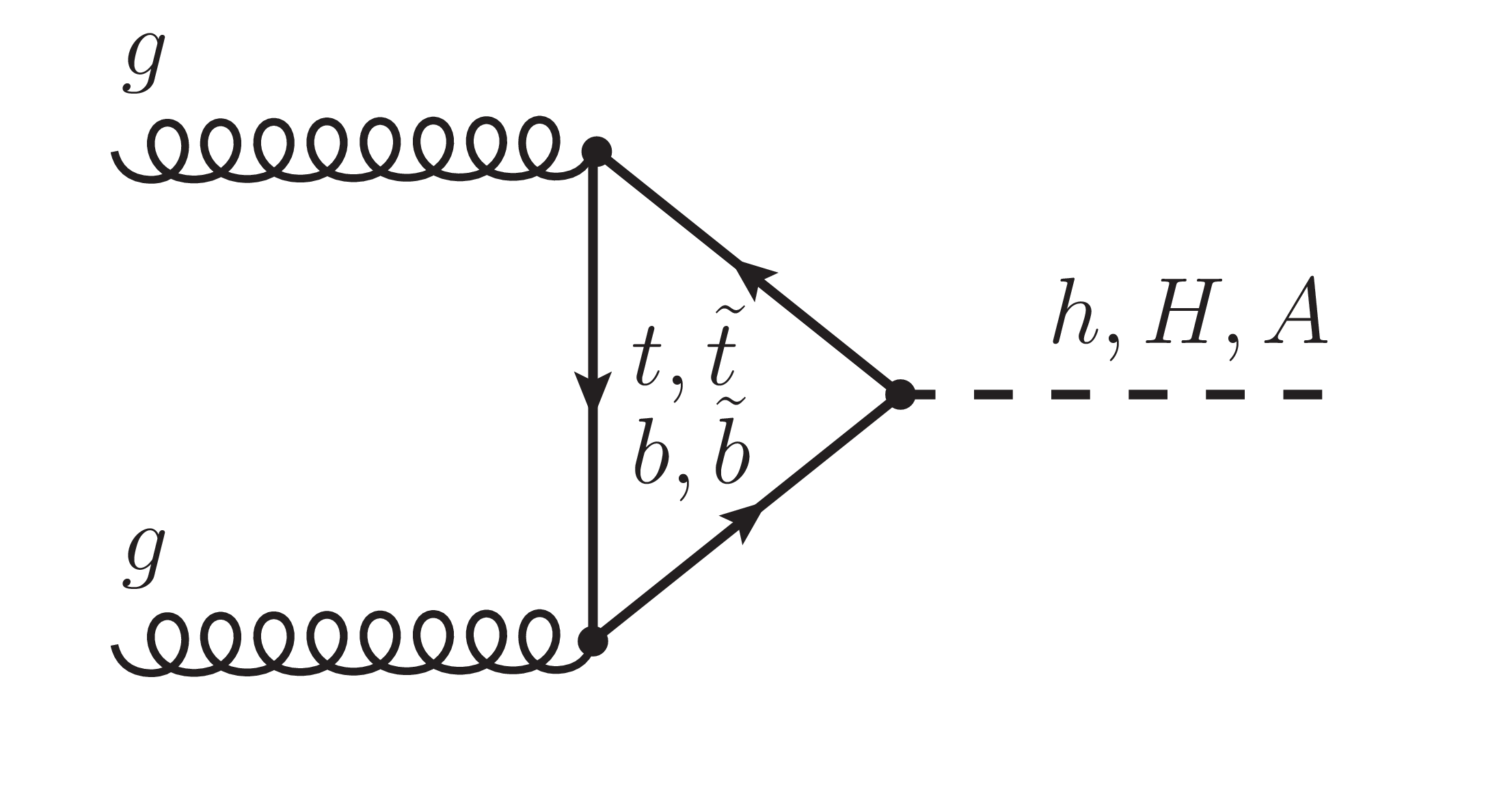
png pdf |
Figure 1-a:
Leading order diagrams for the production of Higgs bosons (left) via gluon-fusion and (middle and right) in association with b quarks. In the middle panel of the figure a pair of b quarks is produced from two gluons (leading order in the four-flavor scheme). In the right panel the Higgs boson is radiated from a b quark in the proton (leading order in the five-flavor scheme). |

png pdf |
Figure 1-b:
Leading order diagrams for the production of Higgs bosons (left) via gluon-fusion and (middle and right) in association with b quarks. In the middle panel of the figure a pair of b quarks is produced from two gluons (leading order in the four-flavor scheme). In the right panel the Higgs boson is radiated from a b quark in the proton (leading order in the five-flavor scheme). |

png pdf |
Figure 1-c:
Leading order diagrams for the production of Higgs bosons (left) via gluon-fusion and (middle and right) in association with b quarks. In the middle panel of the figure a pair of b quarks is produced from two gluons (leading order in the four-flavor scheme). In the right panel the Higgs boson is radiated from a b quark in the proton (leading order in the five-flavor scheme). |
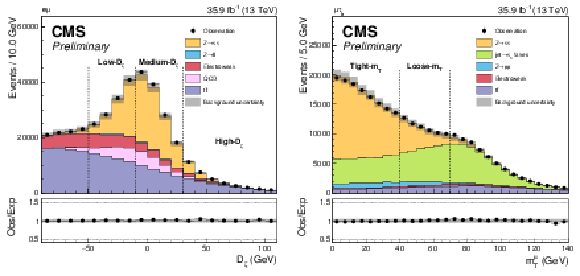
png pdf |
Figure 2:
Observed and expected distributions of (left) $D_{\zeta}$ in the e$ \mu $ final state and (right) $m_{T}^{\mu}$ in the $\mu \tau _{\text {h}} $ final state. The vertical lines in the figures indicate the definition of the sub-categories in each final state. The distributions are shown before any event categorization and prior to the fit used for the statistical inference of the signal. For these figures no uncertainties that effect the shape of the distributions have been included in the uncertainty model. |
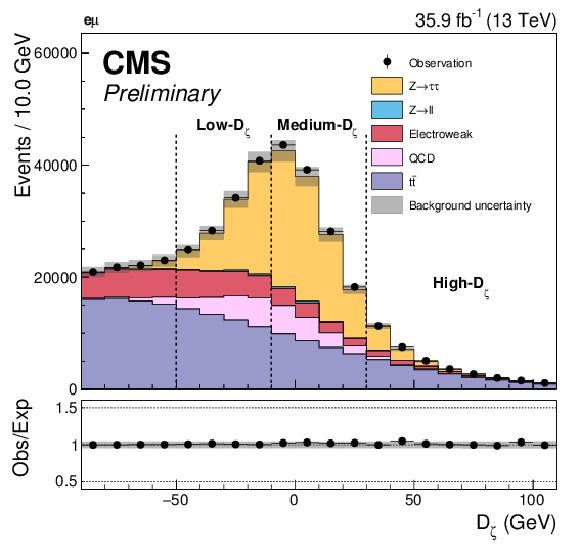
png pdf |
Figure 2-a:
Observed and expected distributions of (left) $D_{\zeta}$ in the e$ \mu $ final state and (right) $m_{T}^{\mu}$ in the $\mu \tau _{\text {h}} $ final state. The vertical lines in the figures indicate the definition of the sub-categories in each final state. The distributions are shown before any event categorization and prior to the fit used for the statistical inference of the signal. For these figures no uncertainties that effect the shape of the distributions have been included in the uncertainty model. |
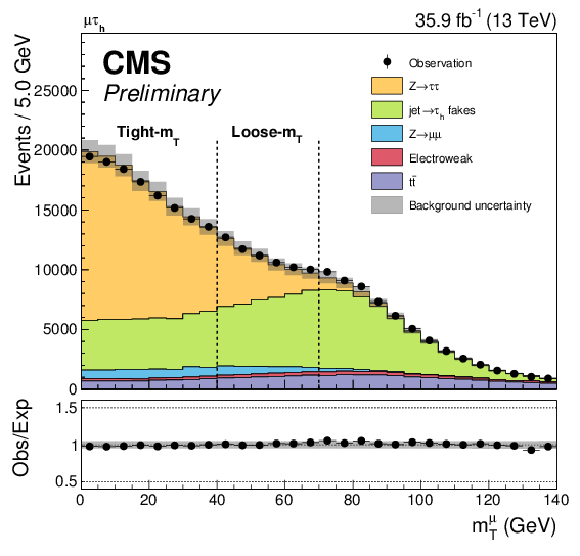
png pdf |
Figure 2-b:
Observed and expected distributions of (left) $D_{\zeta}$ in the e$ \mu $ final state and (right) $m_{T}^{\mu}$ in the $\mu \tau _{\text {h}} $ final state. The vertical lines in the figures indicate the definition of the sub-categories in each final state. The distributions are shown before any event categorization and prior to the fit used for the statistical inference of the signal. For these figures no uncertainties that effect the shape of the distributions have been included in the uncertainty model. |
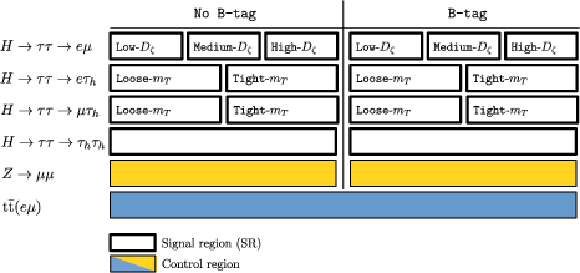
png pdf |
Figure 3:
Overview of all event sub-categories that enter the statistical inference of the signal in the analysis. Sixteen signal categories are complemented by three background control regions in the main analysis as described in Section xxxxx. |

png pdf |
Figure 4:
Schematic view of the determination and application of fake factors for the estimation of the background from QCD multijet, W+jets and ${\mathrm{t} {}\mathrm{\bar{t}}} $ events due to the misidentification of jets as $\tau _{h}$. Note that $ \mathrm{DR}_{{\mathrm{t} {}\mathrm{\bar{t}}}}^{\dagger}$ is taken from simulation. |
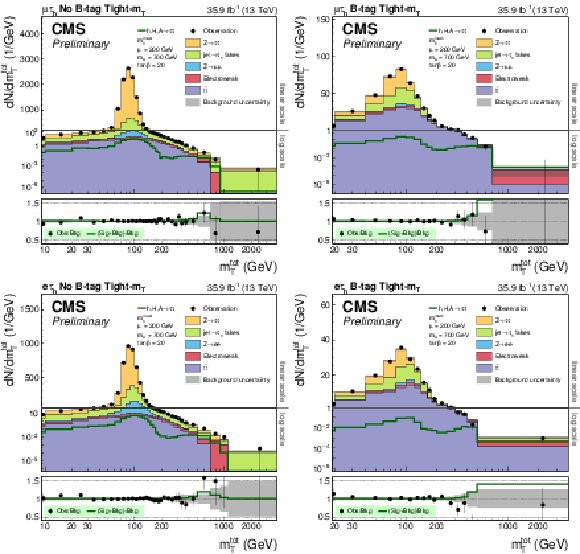
png pdf |
Figure 5:
Distribution of $m_{\text {T}}^{\text {tot}}$ in the global (left) No B-tag and (right) B-tag categories in the (upper row) $\mu \tau _{\text {h}} $ and (lower row) e$ \tau _{\text {h}} $ final states. In all cases the most sensitive Tight-$m_{T}$ event sub-category is shown. The black horizontal line indicates the change from logarithmic to linear scale on the vertical axis. |

png pdf |
Figure 5-a:
Distribution of $m_{\text {T}}^{\text {tot}}$ in the global (left) No B-tag and (right) B-tag categories in the (upper row) $\mu \tau _{\text {h}} $ and (lower row) e$ \tau _{\text {h}} $ final states. In all cases the most sensitive Tight-$m_{T}$ event sub-category is shown. The black horizontal line indicates the change from logarithmic to linear scale on the vertical axis. |

png pdf |
Figure 5-b:
Distribution of $m_{\text {T}}^{\text {tot}}$ in the global (left) No B-tag and (right) B-tag categories in the (upper row) $\mu \tau _{\text {h}} $ and (lower row) e$ \tau _{\text {h}} $ final states. In all cases the most sensitive Tight-$m_{T}$ event sub-category is shown. The black horizontal line indicates the change from logarithmic to linear scale on the vertical axis. |
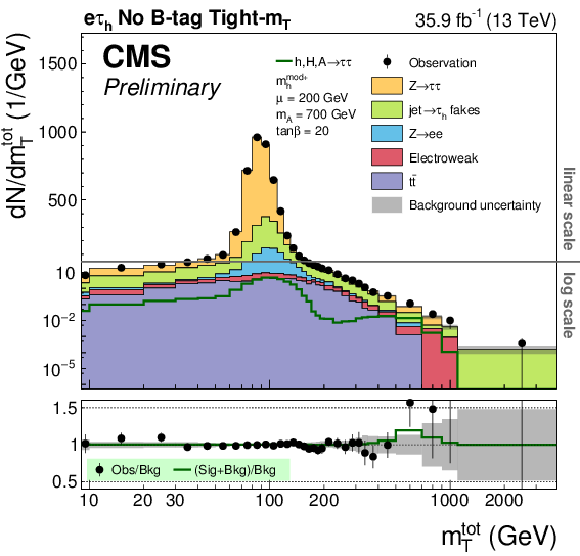
png pdf |
Figure 5-c:
Distribution of $m_{\text {T}}^{\text {tot}}$ in the global (left) No B-tag and (right) B-tag categories in the (upper row) $\mu \tau _{\text {h}} $ and (lower row) e$ \tau _{\text {h}} $ final states. In all cases the most sensitive Tight-$m_{T}$ event sub-category is shown. The black horizontal line indicates the change from logarithmic to linear scale on the vertical axis. |
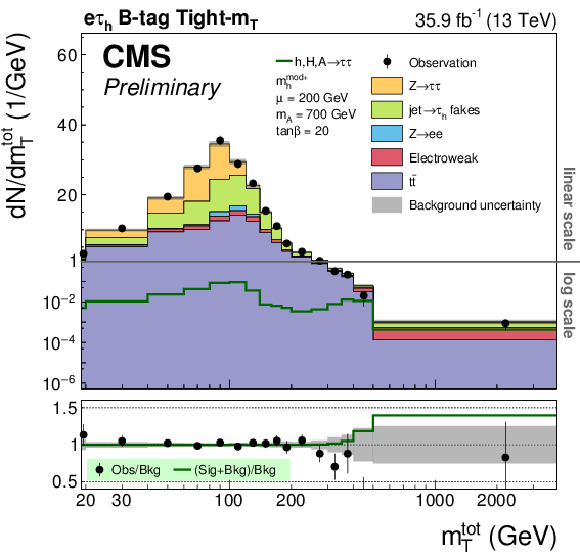
png pdf |
Figure 5-d:
Distribution of $m_{\text {T}}^{\text {tot}}$ in the global (left) No B-tag and (right) B-tag categories in the (upper row) $\mu \tau _{\text {h}} $ and (lower row) e$ \tau _{\text {h}} $ final states. In all cases the most sensitive Tight-$m_{T}$ event sub-category is shown. The black horizontal line indicates the change from logarithmic to linear scale on the vertical axis. |
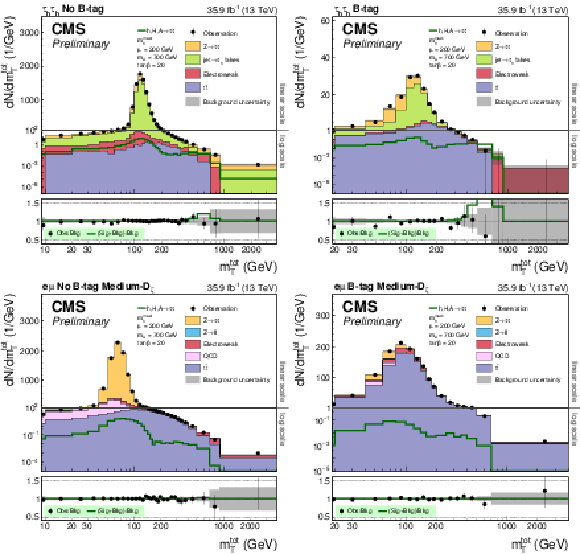
png pdf |
Figure 6:
Distribution of $m_{\text {T}}^{\text {tot}}$ in the global (left) No B-tag and (right) B-tag categories in the (upper row) $\tau _{\text {h}} \tau _{\text {h}} $ and (lower row) e$ \mu $ final states. For the e$ \mu $ final state the most sensitive Medium-$D_{\zeta}$ event sub-category is shown. The black horizontal line indicates the change from logarithmic to linear scale on the vertical axis. |
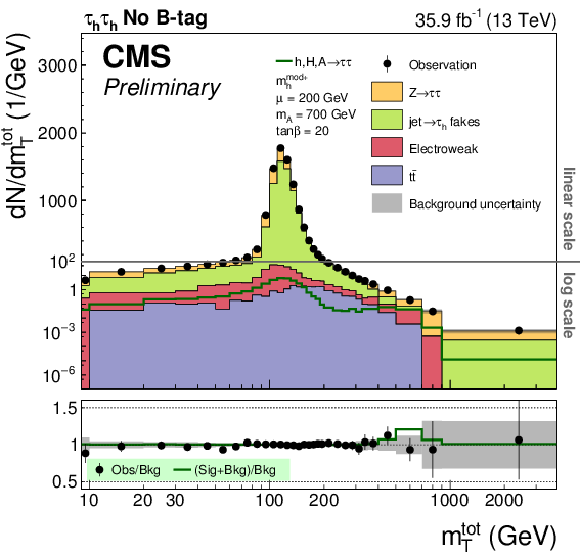
png pdf |
Figure 6-a:
Distribution of $m_{\text {T}}^{\text {tot}}$ in the global (left) No B-tag and (right) B-tag categories in the (upper row) $\tau _{\text {h}} \tau _{\text {h}} $ and (lower row) e$ \mu $ final states. For the e$ \mu $ final state the most sensitive Medium-$D_{\zeta}$ event sub-category is shown. The black horizontal line indicates the change from logarithmic to linear scale on the vertical axis. |
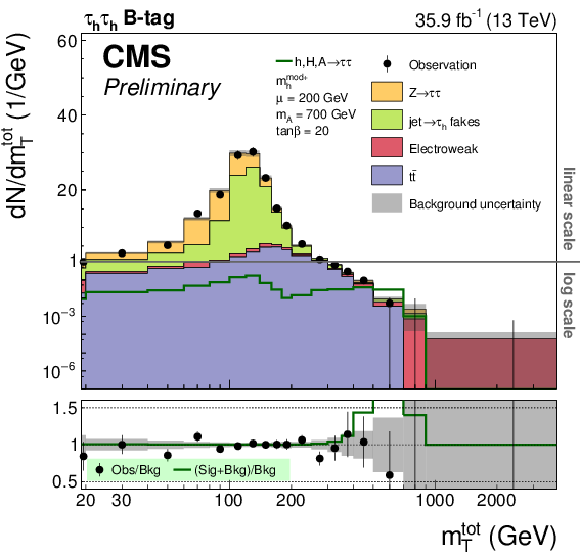
png pdf |
Figure 6-b:
Distribution of $m_{\text {T}}^{\text {tot}}$ in the global (left) No B-tag and (right) B-tag categories in the (upper row) $\tau _{\text {h}} \tau _{\text {h}} $ and (lower row) e$ \mu $ final states. For the e$ \mu $ final state the most sensitive Medium-$D_{\zeta}$ event sub-category is shown. The black horizontal line indicates the change from logarithmic to linear scale on the vertical axis. |
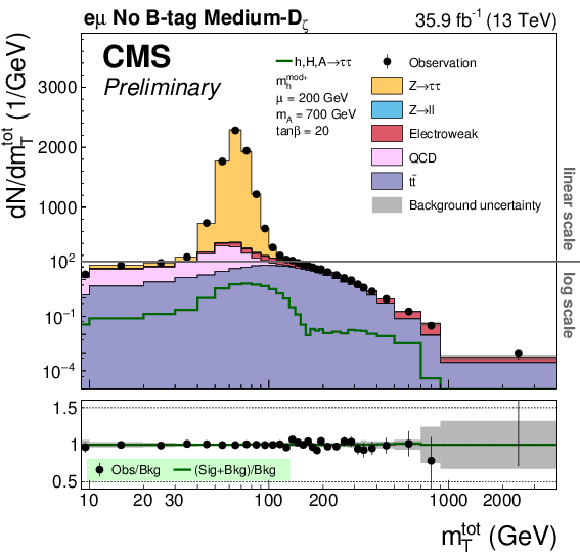
png pdf |
Figure 6-c:
Distribution of $m_{\text {T}}^{\text {tot}}$ in the global (left) No B-tag and (right) B-tag categories in the (upper row) $\tau _{\text {h}} \tau _{\text {h}} $ and (lower row) e$ \mu $ final states. For the e$ \mu $ final state the most sensitive Medium-$D_{\zeta}$ event sub-category is shown. The black horizontal line indicates the change from logarithmic to linear scale on the vertical axis. |
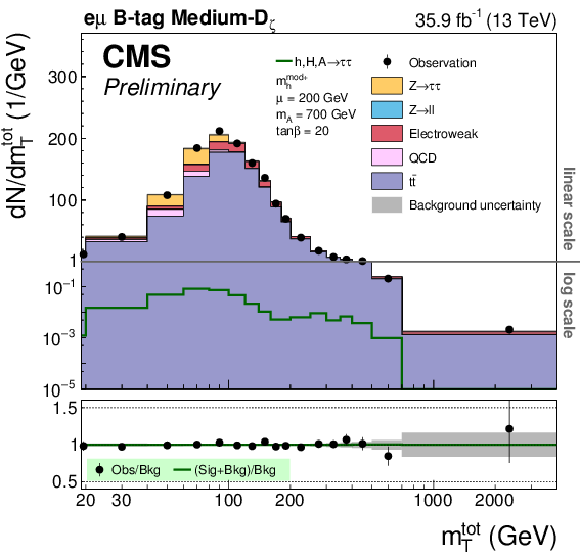
png pdf |
Figure 6-d:
Distribution of $m_{\text {T}}^{\text {tot}}$ in the global (left) No B-tag and (right) B-tag categories in the (upper row) $\tau _{\text {h}} \tau _{\text {h}} $ and (lower row) e$ \mu $ final states. For the e$ \mu $ final state the most sensitive Medium-$D_{\zeta}$ event sub-category is shown. The black horizontal line indicates the change from logarithmic to linear scale on the vertical axis. |
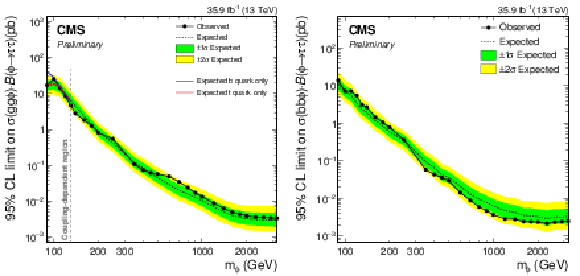
png pdf |
Figure 7:
Expected and observed 95% CL upper limits for the production of a single narrow resonance $\phi $ with a mass between 90 GeV and 3.2 TeV in the di-$\tau $ final state (left) for the production via gluon-fusion and (right) in association with b quarks. The expected median of the exclusion limit is shown by the dashed line. The dark green and bright yellow band indicate the 68% and 95% confidence intervals for the variation of the expected exclusion limit. The black dots correspond to the observed limits. |
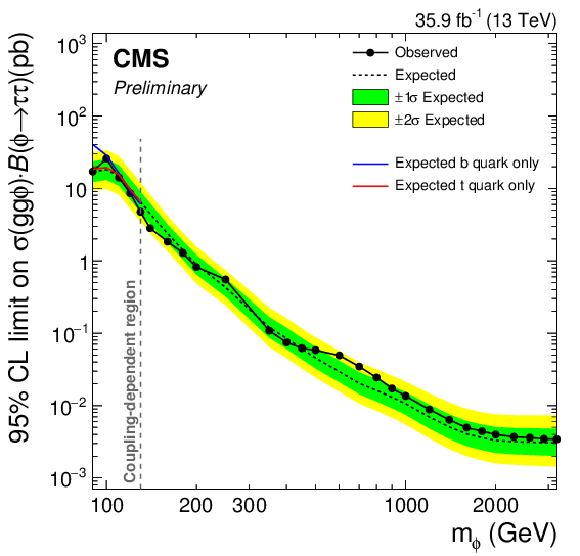
png pdf |
Figure 7-a:
Expected and observed 95% CL upper limits for the production of a single narrow resonance $\phi $ with a mass between 90 GeV and 3.2 TeV in the di-$\tau $ final state (left) for the production via gluon-fusion and (right) in association with b quarks. The expected median of the exclusion limit is shown by the dashed line. The dark green and bright yellow band indicate the 68% and 95% confidence intervals for the variation of the expected exclusion limit. The black dots correspond to the observed limits. |
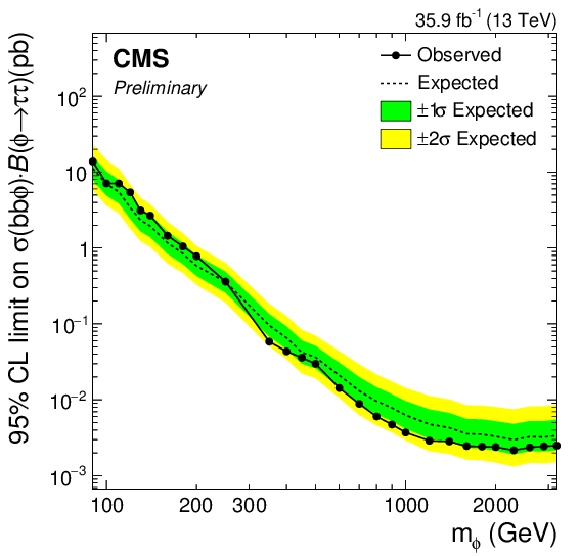
png pdf |
Figure 7-b:
Expected and observed 95% CL upper limits for the production of a single narrow resonance $\phi $ with a mass between 90 GeV and 3.2 TeV in the di-$\tau $ final state (left) for the production via gluon-fusion and (right) in association with b quarks. The expected median of the exclusion limit is shown by the dashed line. The dark green and bright yellow band indicate the 68% and 95% confidence intervals for the variation of the expected exclusion limit. The black dots correspond to the observed limits. |
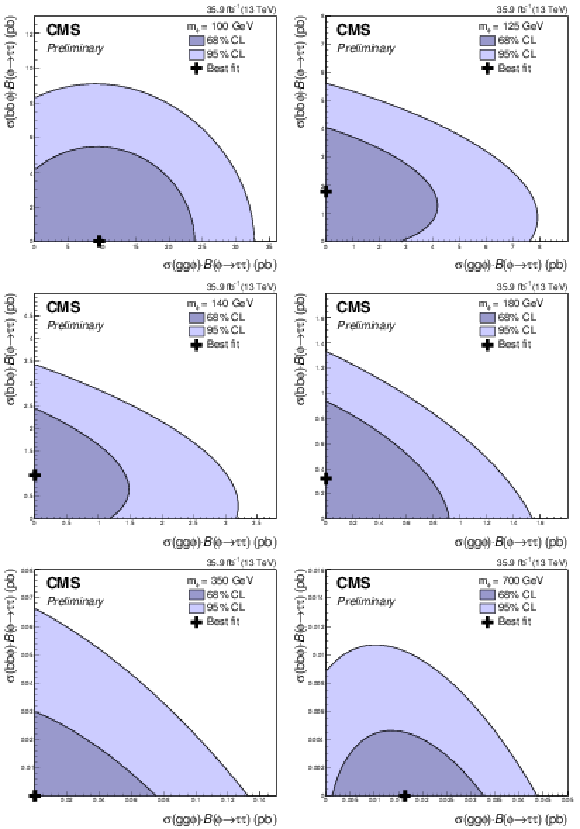
png pdf |
Figure 8:
Scan of the likelihood function for the search in the di-$\tau $ final state for a single narrow resonance $\phi $ produced via gluon-fusion or in association with b quarks. A representative subset of the mass points tested at (upper left) 100 GeV, (upper right) 125 GeV, (middle left) 140 GeV, (middle right) 180 GeV, (lower left) 350 GeV and (lower right) 700 GeV is shown. |
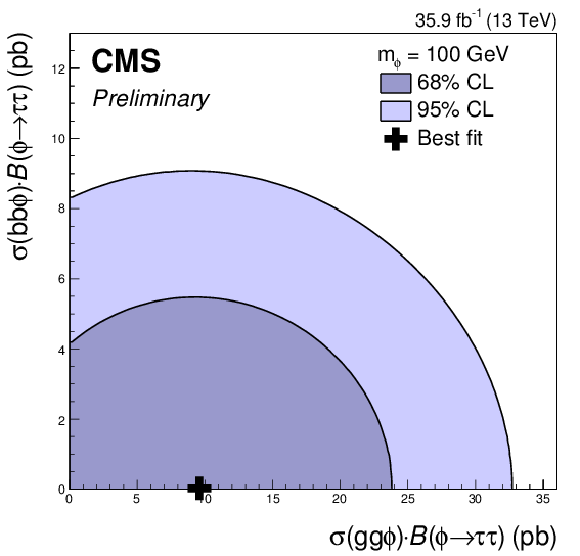
png pdf |
Figure 8-a:
Scan of the likelihood function for the search in the di-$\tau $ final state for a single narrow resonance $\phi $ produced via gluon-fusion or in association with b quarks. A representative subset of the mass points tested at (upper left) 100 GeV, (upper right) 125 GeV, (middle left) 140 GeV, (middle right) 180 GeV, (lower left) 350 GeV and (lower right) 700 GeV is shown. |
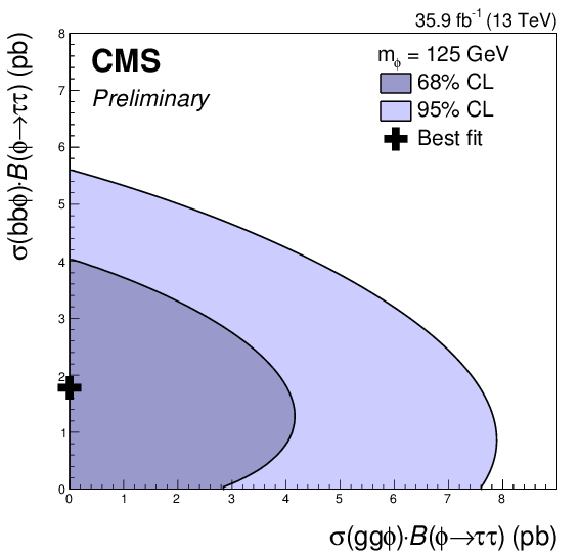
png pdf |
Figure 8-b:
Scan of the likelihood function for the search in the di-$\tau $ final state for a single narrow resonance $\phi $ produced via gluon-fusion or in association with b quarks. A representative subset of the mass points tested at (upper left) 100 GeV, (upper right) 125 GeV, (middle left) 140 GeV, (middle right) 180 GeV, (lower left) 350 GeV and (lower right) 700 GeV is shown. |

png pdf |
Figure 8-c:
Scan of the likelihood function for the search in the di-$\tau $ final state for a single narrow resonance $\phi $ produced via gluon-fusion or in association with b quarks. A representative subset of the mass points tested at (upper left) 100 GeV, (upper right) 125 GeV, (middle left) 140 GeV, (middle right) 180 GeV, (lower left) 350 GeV and (lower right) 700 GeV is shown. |

png pdf |
Figure 8-d:
Scan of the likelihood function for the search in the di-$\tau $ final state for a single narrow resonance $\phi $ produced via gluon-fusion or in association with b quarks. A representative subset of the mass points tested at (upper left) 100 GeV, (upper right) 125 GeV, (middle left) 140 GeV, (middle right) 180 GeV, (lower left) 350 GeV and (lower right) 700 GeV is shown. |
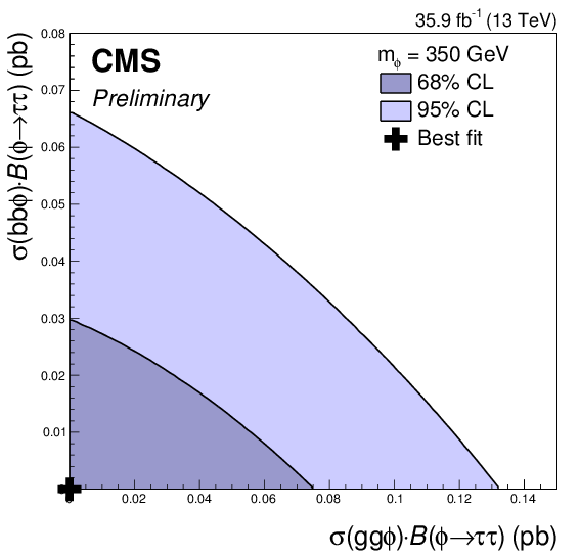
png pdf |
Figure 8-e:
Scan of the likelihood function for the search in the di-$\tau $ final state for a single narrow resonance $\phi $ produced via gluon-fusion or in association with b quarks. A representative subset of the mass points tested at (upper left) 100 GeV, (upper right) 125 GeV, (middle left) 140 GeV, (middle right) 180 GeV, (lower left) 350 GeV and (lower right) 700 GeV is shown. |
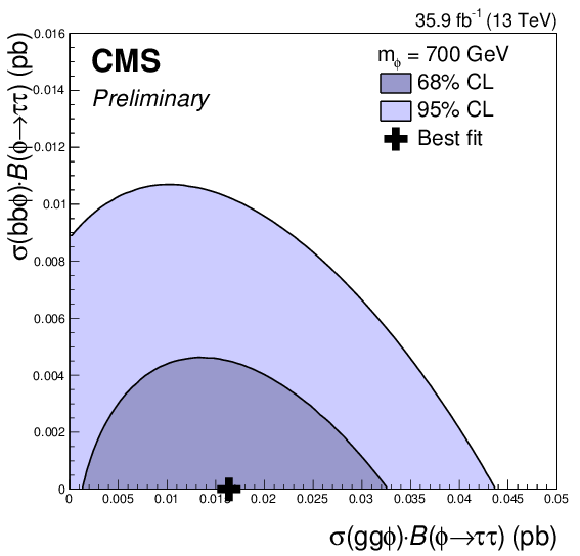
png pdf |
Figure 8-f:
Scan of the likelihood function for the search in the di-$\tau $ final state for a single narrow resonance $\phi $ produced via gluon-fusion or in association with b quarks. A representative subset of the mass points tested at (upper left) 100 GeV, (upper right) 125 GeV, (middle left) 140 GeV, (middle right) 180 GeV, (lower left) 350 GeV and (lower right) 700 GeV is shown. |
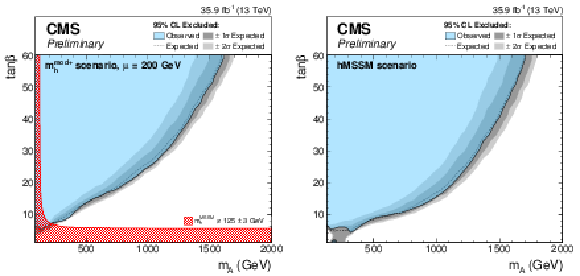
png pdf |
Figure 9:
Expected and observed 95% CL exclusion contour (left) in the MSSM $m_{\mathrm{h}}^{\text {mod+}}$ and (right) in the hMSSM scenario. The expected median is shown as a dashed black line. The dark and bright gray bands indicate the 68% and 95% confidence intervals for the variation of the expected exclusion. The observed exclusion contour is indicated by the colored blue area. |
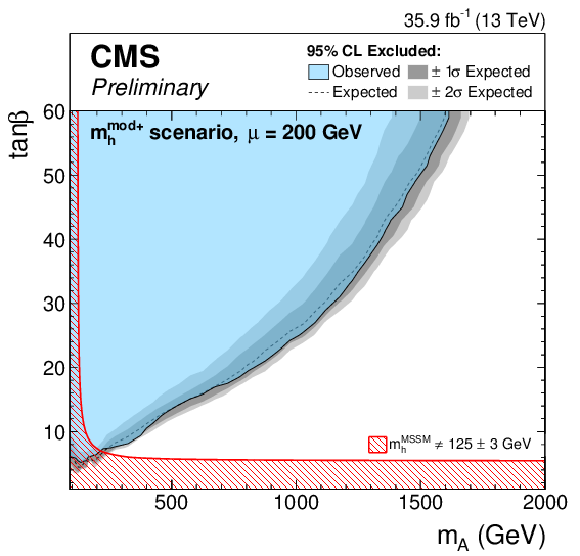
png pdf |
Figure 9-a:
Expected and observed 95% CL exclusion contour (left) in the MSSM $m_{\mathrm{h}}^{\text {mod+}}$ and (right) in the hMSSM scenario. The expected median is shown as a dashed black line. The dark and bright gray bands indicate the 68% and 95% confidence intervals for the variation of the expected exclusion. The observed exclusion contour is indicated by the colored blue area. |
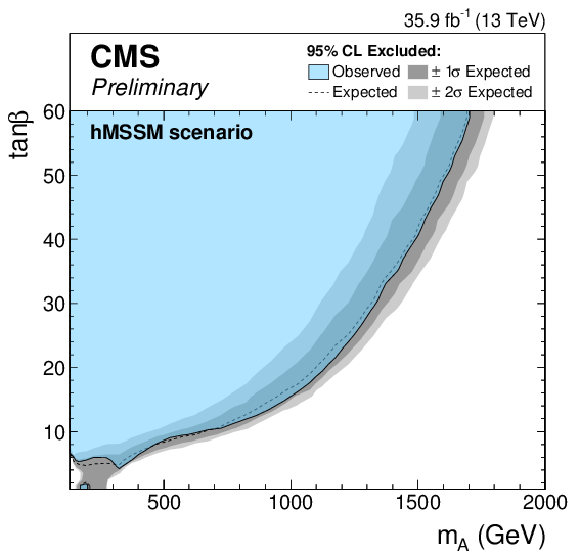
png pdf |
Figure 9-b:
Expected and observed 95% CL exclusion contour (left) in the MSSM $m_{\mathrm{h}}^{\text {mod+}}$ and (right) in the hMSSM scenario. The expected median is shown as a dashed black line. The dark and bright gray bands indicate the 68% and 95% confidence intervals for the variation of the expected exclusion. The observed exclusion contour is indicated by the colored blue area. |
| Tables | |

png pdf |
Table 1:
Kinematic selection of the final state objects in the e$ \mu $, e$ \tau _{\text {h}} $, $\mu \tau _{\text {h}} $ and $\tau _{\text {h}} \tau _{\text {h}} $ final state. The expression "first (second) lepton'' refers to the channel label used in the first column. |
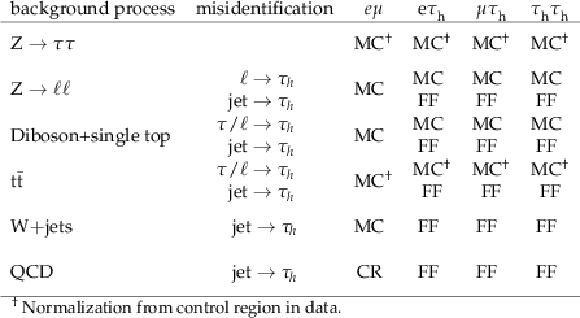
png pdf |
Table 2:
Background processes contributing to the event selection as given in Section yyyyy. The further splitting of the processes in the second column refers only to final states with a $\tau _{h}$ candidate. MC implies that the process is taken from simulation, FF implies that the process is determined from data using fake factors as described in the text. The symbol CR implies that both the shape and normalization of QCD multijet events are estimated from control regions in data. The label $\ell $ corresponds to an electron or muon. |
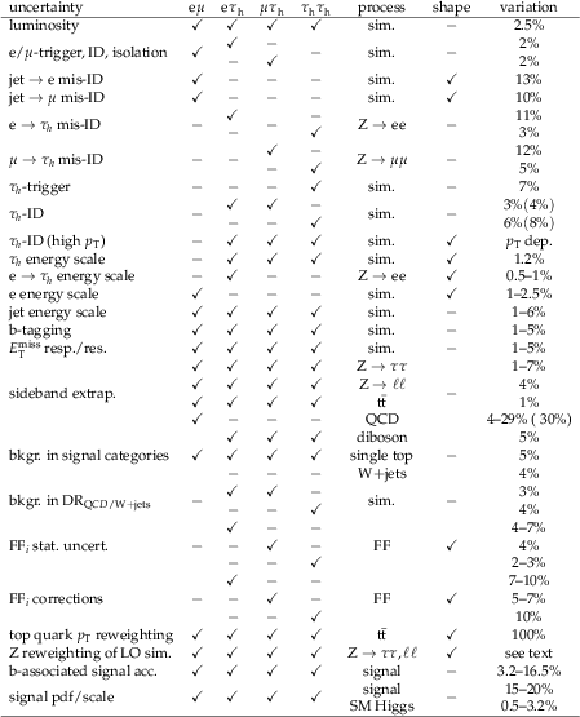
png pdf |
Table 3:
Overview of the systematic uncertainties used in the likelihood model for the statistical inference of the signal. The expression "sim.'' refers to all processes that have been obtained from simulation, the expression "FF'' refers to all backgrounds that are obtained from the fake factor method. Values in brackets correspond to additional uncertainties correlated across final states or event categories. Detailed descriptions are given in the text. |
| Summary |
| A search for additional heavy neutral Higgs bosons in the decay into two tau leptons in the context of the MSSM has been presented. This search has been performed in the most sensitive e$ \mu $, e$ \tau_{\mathrm{h}} $, $\mu\tau_{\mathrm{h}}$ and $\tau_{\mathrm{h}}\tau_{\mathrm{h}}$ final states of the di-$\tau$ pair, where $\tau_{h}$ indicates a hadronic $\tau$ decay. The sensitivity of the analysis has been increased by splitting the resulting events into sixteen signal categories. These have been complemented by three control regions to constrain the normalization of the backgrounds from Drell-Yan and $\mathrm{t\bar{t}}$ events in situ during the fits to the data that are performed for the statistical inference of the signal. The signal categorization is motivated by the expected enhancement of the coupling of the heavy neutral Higgs bosons to down-type fermions for the most interesting MSSM parameter space, corresponding to values of $\tan\beta > $ 1. This enhancement influences the kinematics of the production via gluon-fusion and leads to an increased cross section for b-associated production. A signal has been searched for in a combined maximum likelihood fit to all signal categories and control regions in all final states under investigation. No signal has been found. Model-independent limits have been set for the production of a single narrow resonance. These range from 18 pb (at 90 GeV) to 3.5 $\times 10^{-3}$ pb (at 3.2 TeV) for the production via gluon-fusion and from 15 pb (at 90 GeV) to 2.5 $ \times 10^{-3}$ pb (at 3.2 TeV) for b-associated production. These limits are supplemented by a three dimensional likelihood scan as a function of the product of the production cross section and di-$\tau$ branching fraction for gluon-fusion, b-associated production and the tested mass. Finally exclusion contours have been provided for two representative benchmark scenarios namely the $m_{h}^{\text{mod+}}$ and the hMSSM scenarios. In these two scenarios the presence of a neutral heavy MSSM Higgs boson up to $m_{A} < $ 250 GeV is excluded for $\tan\beta$ values above 6. The exclusion contour ranges up to 1.6 TeV for $\tan\beta < $ 60. |
| Additional Figures | |
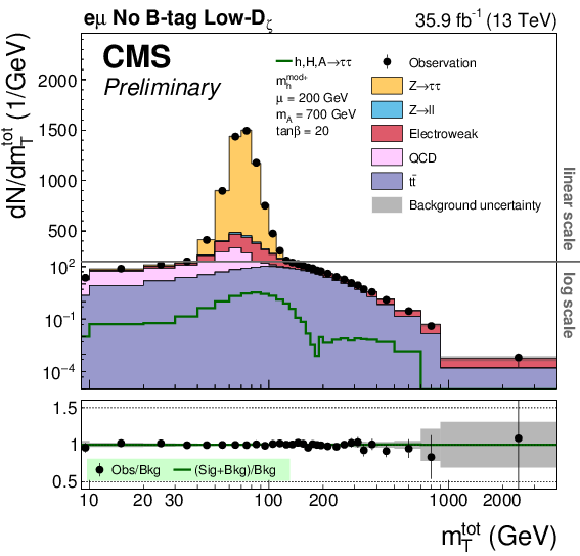
png pdf |
Additional Figure 1:
Distribution of $m_{\text {T}}^{\text {tot}}$ in the No B-Tag Low-$D_{\zeta}$ event category in the $\mathrm{e} \mu $ final state. |
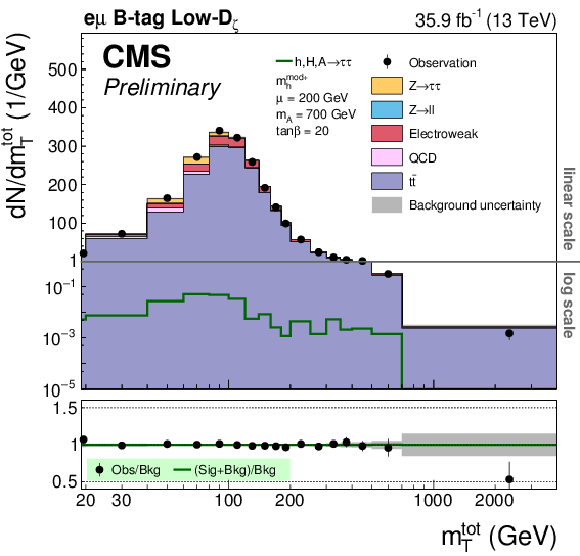
png pdf |
Additional Figure 2:
Distribution of $m_{\text {T}}^{\text {tot}}$ in the B-Tag Low-$D_{\zeta}$ event category in the $\mathrm{e} \mu $ final state. |
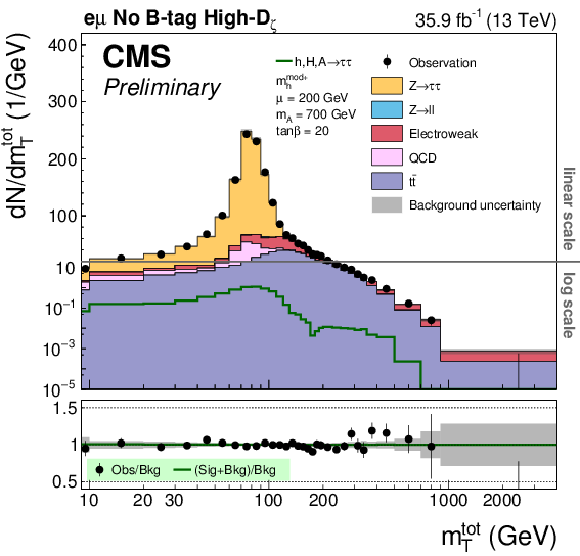
png pdf |
Additional Figure 3:
Distribution of $m_{\text {T}}^{\text {tot}}$ in the No B-Tag High-$D_{\zeta}$ event category in the $\mathrm{e} \mu $ final state. |
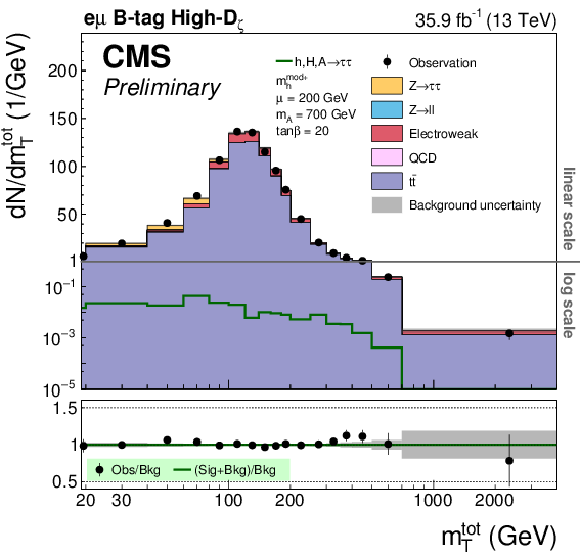
png pdf |
Additional Figure 4:
Distribution of $m_{\text {T}}^{\text {tot}}$ in the B-Tag High-$D_{\zeta}$ event category in the $\mathrm{e} \mu $ final state. |
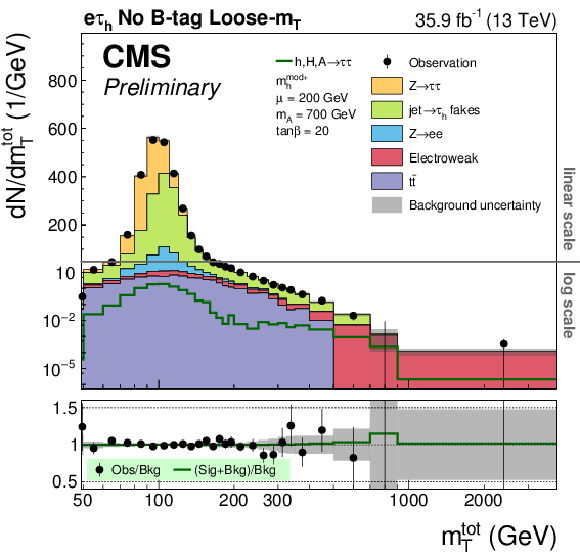
png pdf |
Additional Figure 5:
Distribution of $m_{\text {T}}^{\text {tot}}$ in the No B-Tag Loose-$m_{\text {T}}$ event category in the $\mathrm{e} \tau _{\text {h}} $ final state. |
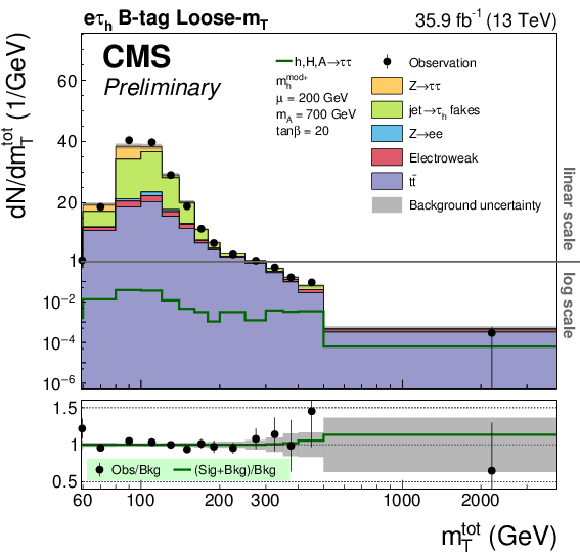
png pdf |
Additional Figure 6:
Distribution of $m_{\text {T}}^{\text {tot}}$ in the B-Tag Loose-$m_{\text {T}}$ event category in the $\mathrm{e} \tau _{\text {h}} $ final state. |

png pdf |
Additional Figure 7:
Distribution of $m_{\text {T}}^{\text {tot}}$ in the No B-Tag Loose-$m_{\text {T}}$ event category in the $\mu \tau _{\text {h}} $ final state. |
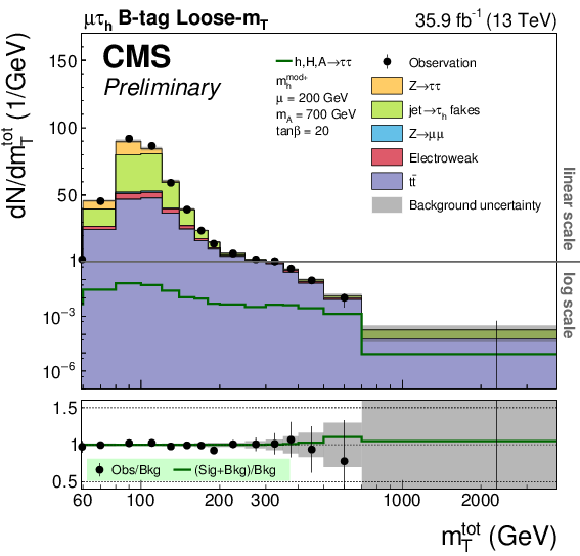
png pdf |
Additional Figure 8:
Distribution of $m_{\text {T}}^{\text {tot}}$ in the B-Tag Loose-$m_{\text {T}}$ event category in the $\mu \tau _{\text {h}} $ final state. |
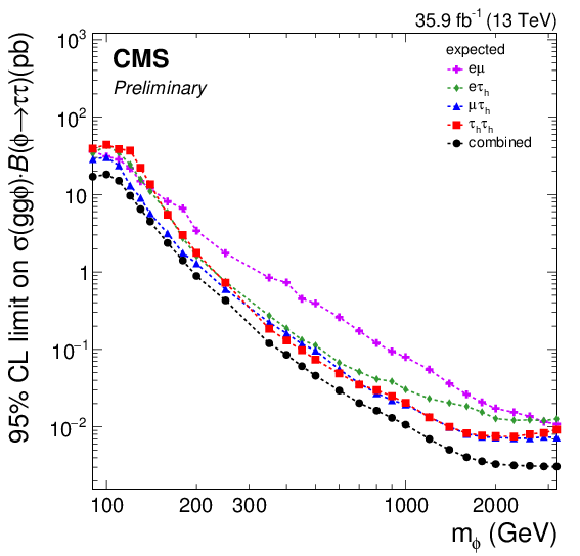
png pdf |
Additional Figure 9:
Expected 95% CL upper limits for the production of a single narrow resonance $\phi $ with a mass between 90 GeV and 3.2 TeV in the di-$\tau $ final state via gluon-fusion, split by final state. For these limits the SM Higgs boson has been added to the non-Higgs SM background. |
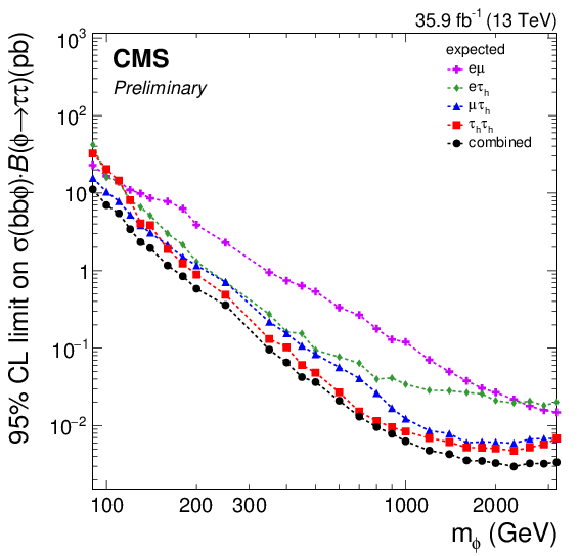
png pdf |
Additional Figure 10:
Expected 95% CL upper limits for the b-associated production of a single narrow resonance $\phi $ with a mass between 90 GeV and 3.2 TeV in the di-$\tau $ final state, split by final state. For these limits the SM Higgs boson has been added to the non-Higgs SM background. |
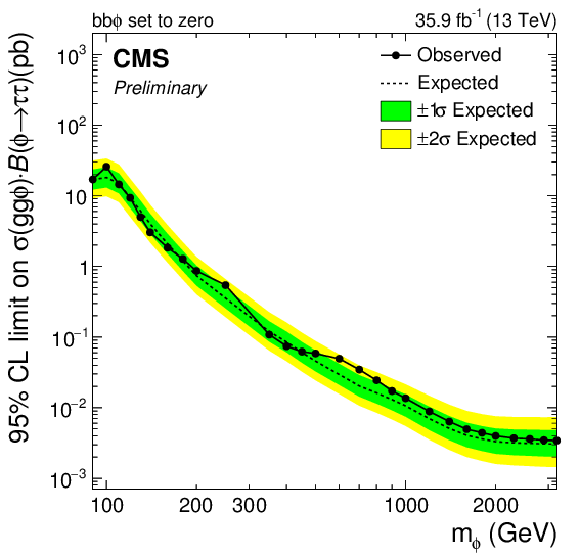
png pdf |
Additional Figure 11:
Expected and observed 95% CL upper limits for the production of a single narrow resonance $\phi $ with a mass between 90 GeV and 3.2 TeV in the di-$\tau $ final state via gluon-fusion. For these limits the cross section for b-associated production has been set to zero; the SM Higgs boson has been added to the non-Higgs SM background. |
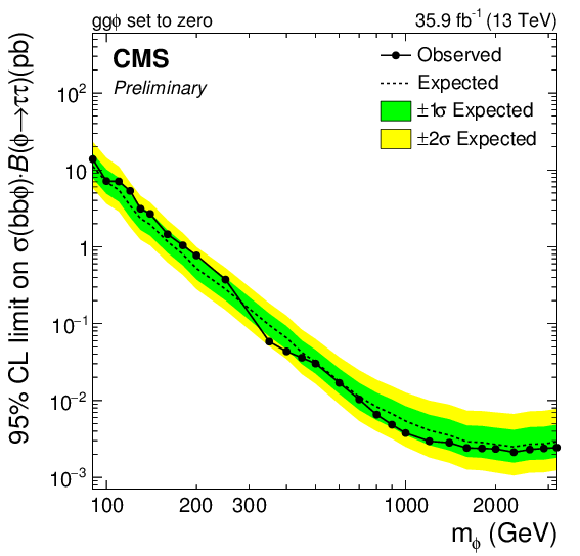
png pdf |
Additional Figure 12:
Expected and observed 95% CL upper limits for the b-associated production of a single narrow resonance $\phi $ with a mass between 90 GeV and 3.2 TeV in the di-$\tau $ final state. For these limits the cross section for the production via gluon-fusion has been set to zero; the SM Higgs boson has been added to the non-Higgs SM background. |
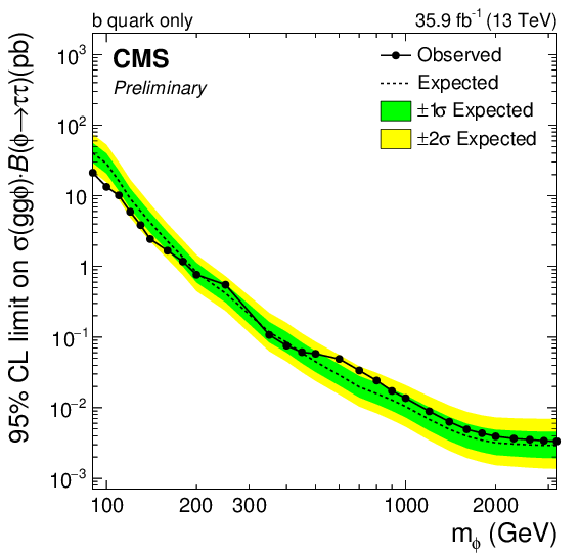
png pdf |
Additional Figure 13:
Expected and observed 95% CL upper limits for the production of a single narrow resonance $\phi $ with a mass between 90 GeV and 3.2 TeV in the di-$\tau $ final state via gluon-fusion. For these limits only b quarks have been considered in the gluon-fusion loop; the SM Higgs boson has been added to the non-Higgs SM background. |
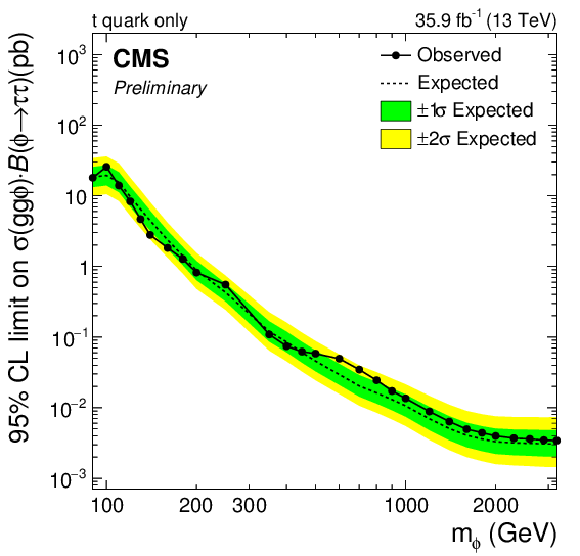
png pdf |
Additional Figure 14:
Expected and observed 95% CL upper limits for the production of a single narrow resonance $\phi $ with a mass between 90 GeV and 3.2 TeV in the di-$\tau $ final state via gluon-fusion. For these limits only t quarks have been considered in the gluon-fusion loop; the SM Higgs boson has been added to the non-Higgs SM background. |
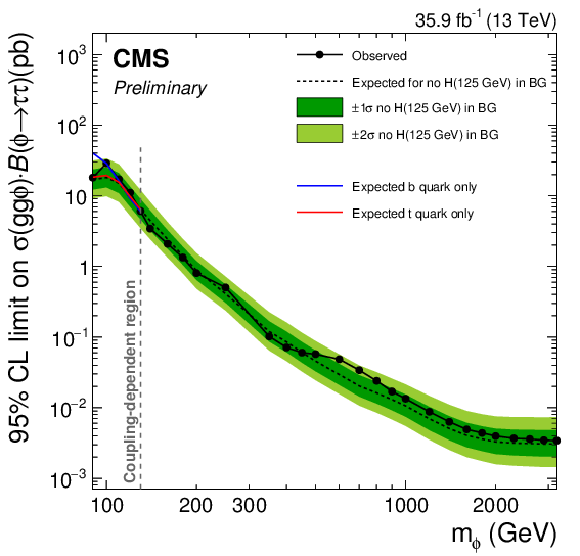
png pdf |
Additional Figure 15:
Expected and observed 95% CL upper limits for the production of a single narrow resonance $\phi $ with a mass between 90 GeV and 3.2 TeV in the di-$\tau $ final state via gluon-fusion. For these limits the SM Higgs boson has not been included in the background model. |
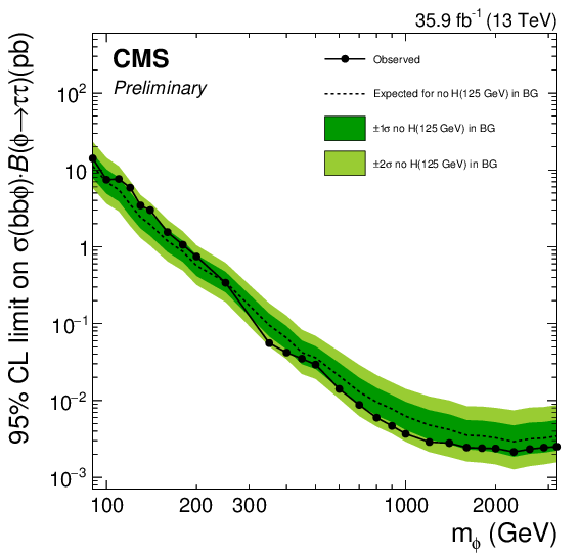
png pdf |
Additional Figure 16:
Expected and observed 95% CL upper limits for the b-associated production of a single narrow resonance $\phi $ with a mass between 90 GeV and 3.2 TeV in the di-$\tau $ final state. For these limits the SM Higgs boson has not been included in the background model. |
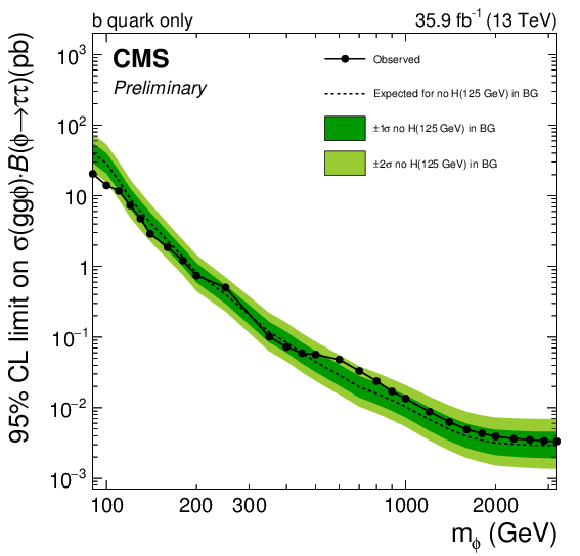
png pdf |
Additional Figure 17:
Expected and observed 95% CL upper limits for the production of a single narrow resonance $\phi $ with a mass between 90 GeV and 3.2 TeV in the di-$\tau $ final state via gluon-fusion. For these limits only b quarks have been considered in the gluon-fusion loop; the SM Higgs boson has not been included in the background model. |
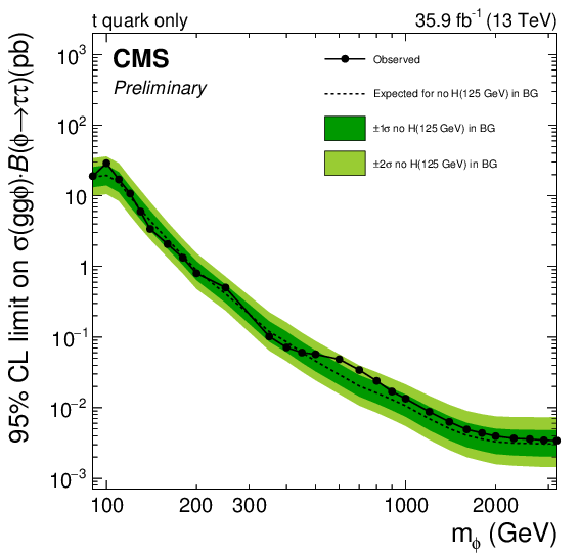
png pdf |
Additional Figure 18:
Expected and observed 95% CL upper limits for the production of a single narrow resonance $\phi $ with a mass between 90 GeV and 3.2 TeV in the di-$\tau $ final state via gluon-fusion. For these limits only t quarks have been considered in the gluon-fusion loop; the SM Higgs boson has not been included in the background model. |
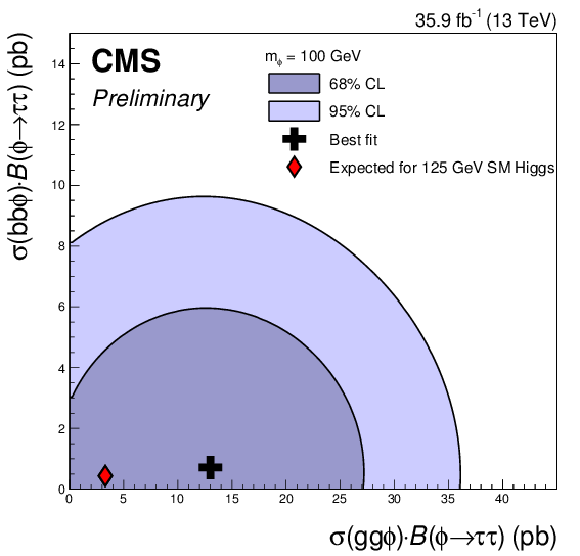
png pdf |
Additional Figure 19:
Scan of the likelihood function used for the search for a single narrow resonance $\phi $, with a mass of 100 GeV, produced via gluon-fusion or in b-associated production in the di-$\tau $ final state. For this scan the SM Higgs boson has not been included in the background model. |
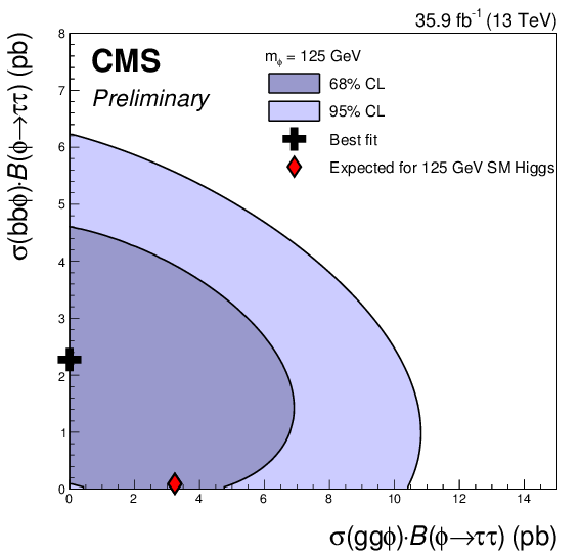
png pdf |
Additional Figure 20:
Scan of the likelihood function used for the search for a single narrow resonance $\phi $, with a mass of 125 GeV, produced via gluon-fusion or in b-associated production in the di-$\tau $ final state. For this scan the SM Higgs boson has not been included in the background model. |
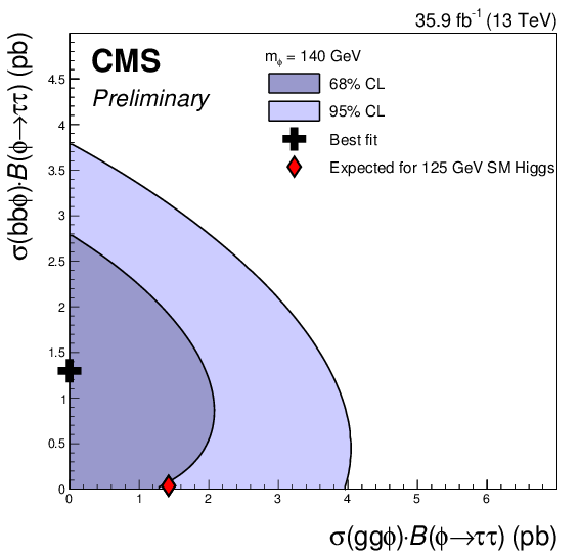
png pdf |
Additional Figure 21:
Scan of the likelihood function used for the search for a single narrow resonance $\phi $, with a mass of 140 GeV, produced via gluon-fusion or in b-associated production in the di-$\tau $ final state. For this scan the SM Higgs boson has not been included in the background model. |
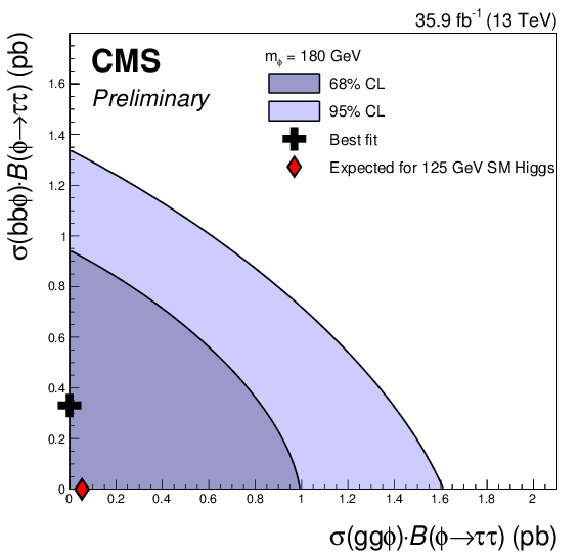
png pdf |
Additional Figure 22:
Scan of the likelihood function used for the search for a single narrow resonance $\phi $, with a mass of 180 GeV, produced via gluon-fusion or in b-associated production in the di-$\tau $ final state. For this scan the SM Higgs boson has not been included in the background model. |
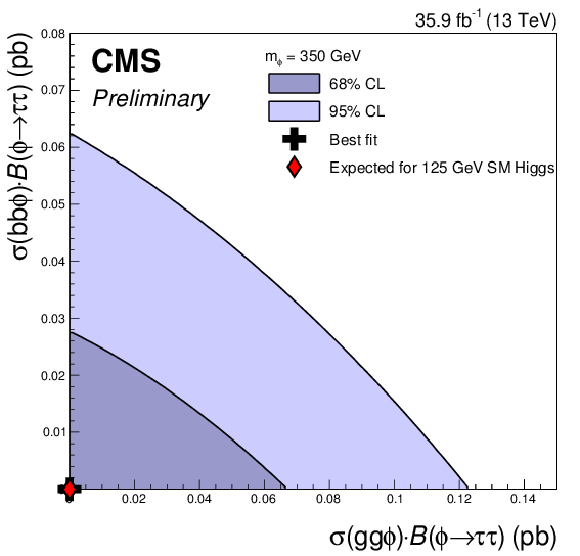
png pdf |
Additional Figure 23:
Scan of the likelihood function used for the search for a single narrow resonance $\phi $, with a mass of 350 GeV, produced via gluon-fusion or in b-associated production in the di-$\tau $ final state. For this scan the SM Higgs boson has not been included in the background model. |

png pdf |
Additional Figure 24:
Scan of the likelihood function used for the search for a single narrow resonance $\phi $, with a mass of 700 GeV, produced via gluon-fusion or in b-associated production in the di-$\tau $ final state. For this scan the SM Higgs boson has not been included in the background model. |
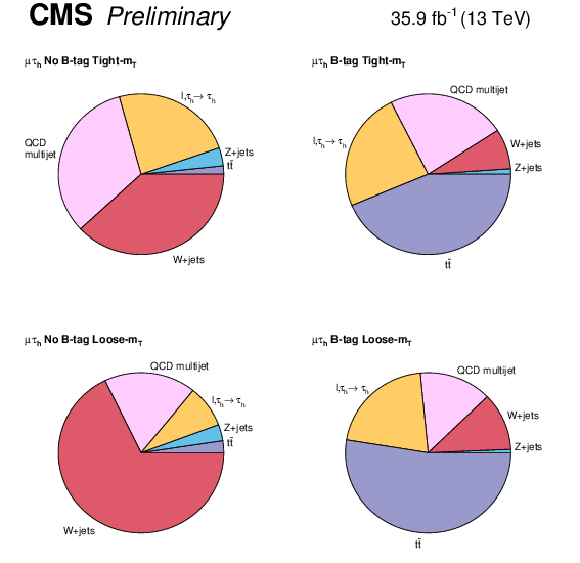
png pdf |
Additional Figure 25:
Composition of the data in the AR used for the fake factor method, split by processes and as expected from the simulation, in the $\mu \tau _{\text {h}} $ final state. |
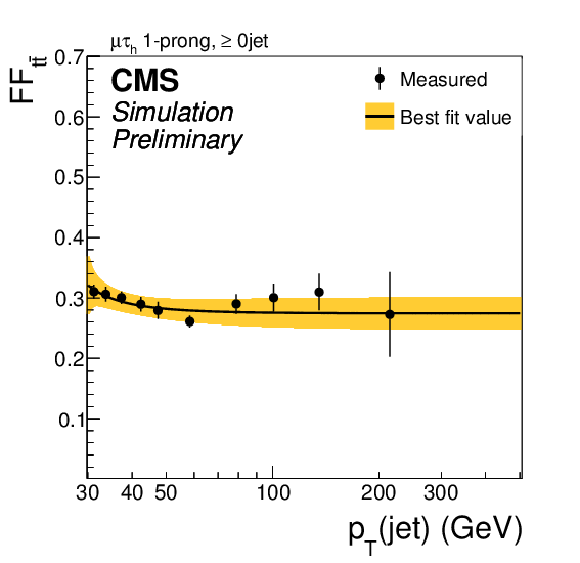
png pdf |
Additional Figure 26:
Fake factor, FF$_{{\mathrm{t} {}\mathrm{\bar{t}}}}$, as obtained from simulation as a function of the transverse momentum of the misidentified jet in the 1-prong $N_{\text {jet}}= $ 0 category, in the $\mu \tau _{\text {h}} $ final state. |

png pdf |
Additional Figure 27:
Fake factor, FF$_{\text {QCD}}$, as obtained from DR$_{\text {QCD}}$ as a function of the transverse momentum of the misidentified jet in the 1-prong $N_{\text {jet}}= $ 0 category, in the $\mu \tau _{\text {h}} $ final state. |

png pdf |
Additional Figure 28:
Fake factor, FF$_{{\mathrm{W}}{+}\text {jets}}$, as obtained from DR$_{{\mathrm{W}}{+}\text {jets}}$ as a function of the transverse momentum of the misidentified jet in the 1-prong $N_{\text {jet}}= $ 0 category, in the $\mu \tau _{\text {h}} $ final state. |
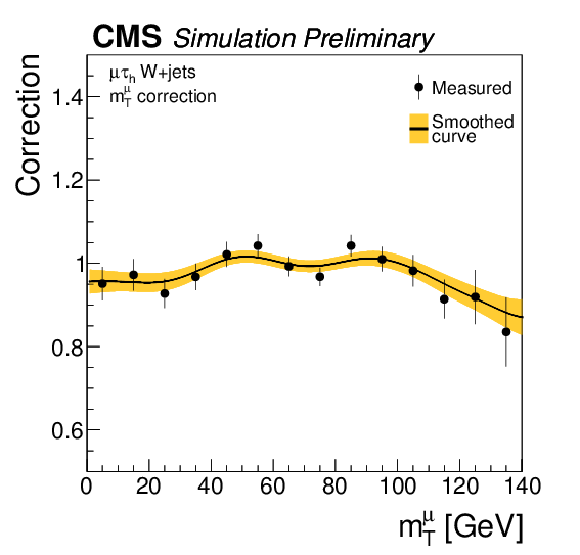
png pdf |
Additional Figure 29:
Correction to FF$_{{\mathrm{W}}{+}\text {jets}}$ to account for differences between the event kinematics in the SR relative to DR$_{{\mathrm{W}}{+}\text {jets}}$. The correction has been obtained as a function of $m_{\text {T}}^{\mu}$ from the simulation in the $\mu \tau _{\text {h}} $ final state. |
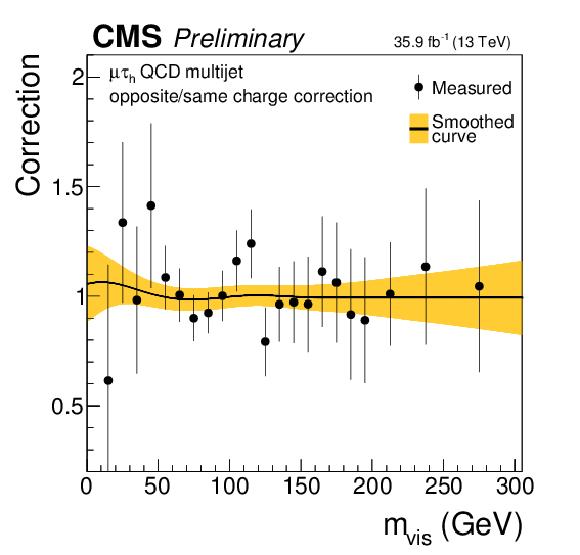
png pdf |
Additional Figure 30:
Correction to FF$_{\text {QCD}}$ to account for differences between the opposite charge requirement on the selected di-$\tau $ pair in the SR with respect to the same charge requirement in DR$_{\text {QCD}}$. This correction has been obtained as a function of the mass of the visible decay products of the di-$\tau $ system, $m_{\text {vis}}$, from a sideband region in data, where the isolation requirement on the muon has been chosen orthogonal to the SR in the $\mu \tau _{\text {h}} $ final state. |

png pdf |
Additional Figure 31:
Composition of the data in the AR used for the fake factor method, split by processes and as expected from the simulation, in the $\mathrm{e} \tau _{\text {h}} $ final state. |
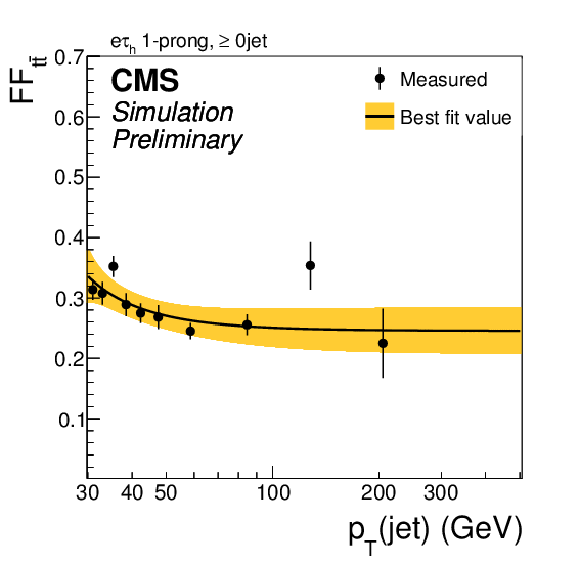
png pdf |
Additional Figure 32:
Fake factor, FF$_{{\mathrm{t} {}\mathrm{\bar{t}}}}$, as obtained from simulation as a function of the transverse momentum of the misidentified jet in the 1-prong $N_{\text {jet}}= $ 0 category, in the $\mathrm{e} \tau _{\text {h}} $ final state. |
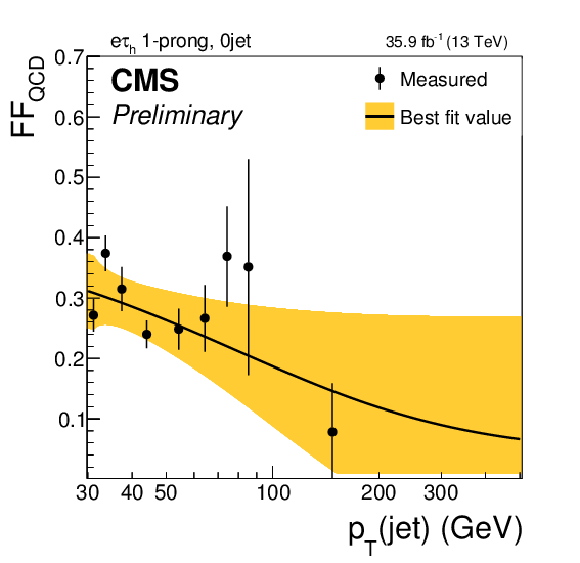
png pdf |
Additional Figure 33:
Fake factor, FF$_{\text {QCD}}$, as obtained from DR$_{\text {QCD}}$ as a function of the transverse momentum of the misidentified jet in the 1-prong $N_{\text {jet}}= $ 0 category, in the $\mathrm{e} \tau _{\text {h}} $ final state. |

png pdf |
Additional Figure 34:
Fake factor, FF$_{{\mathrm{W}}{+}\text {jets}}$, as obtained from DR$_{{\mathrm{W}}{+}\text {jets}}$ as a function of the transverse momentum of the misidentified jet in the 1-prong $N_{\text {jet}}= $ 0 category, in the $\mathrm{e} \tau _{\text {h}} $ final state. |
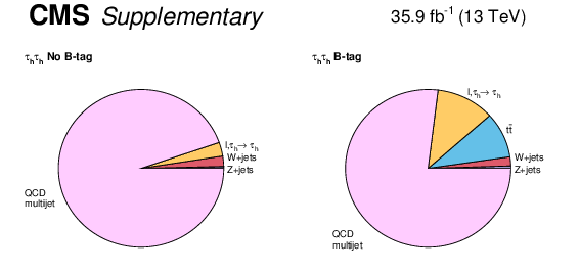
png pdf |
Additional Figure 35:
Composition of the data in the AR used for the fake factor method, split by processes and as expected from the simulation, in the $\tau _{\text {h}} \tau _{\text {h}} $ final state. |
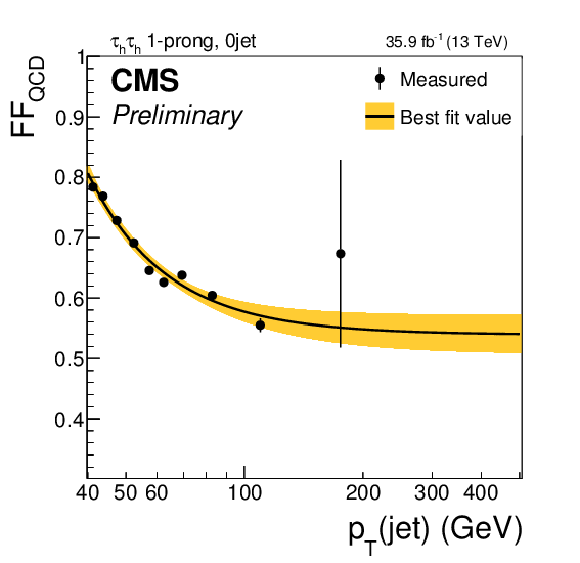
png pdf |
Additional Figure 36:
Fake factor, FF$_{\text {QCD}}$, as obtained from DR$_{\text {QCD}}$ as a function of the transverse momentum of the misidentified jet in the 1-prong $N_{\text {jet}}= $ 0 category in the $\tau _{\text {h}} \tau _{\text {h}} $ final state. |
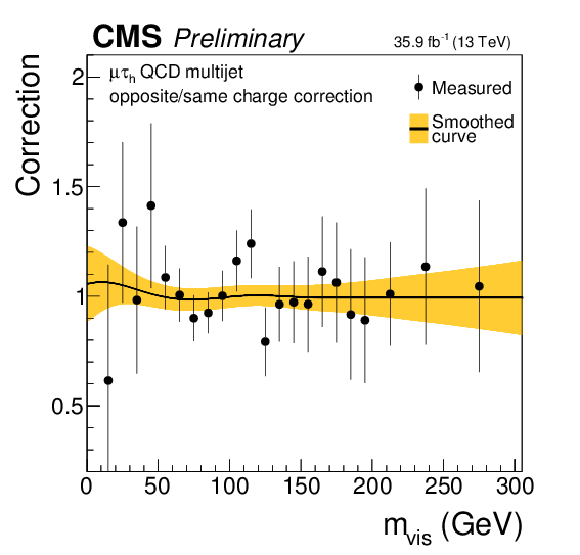
png pdf |
Additional Figure 37:
Correction to FF$_{\text {QCD}}$ to account for differences between the opposite charge requirement on the selected di-$\tau $ pair in the SR with respect to the same charge requirement in DR$_{\text {QCD}}$. This correction has been obtained as a function of the mass of the visible decay products of the di-$\tau $ system, $m_{\text {vis}}$, from a sideband region in data, where the isolation requirement on the other $\tau _{h}$ candidate has been chosen orthogonal to the SR in the $\mu \tau _{\text {h}} $ final state. |
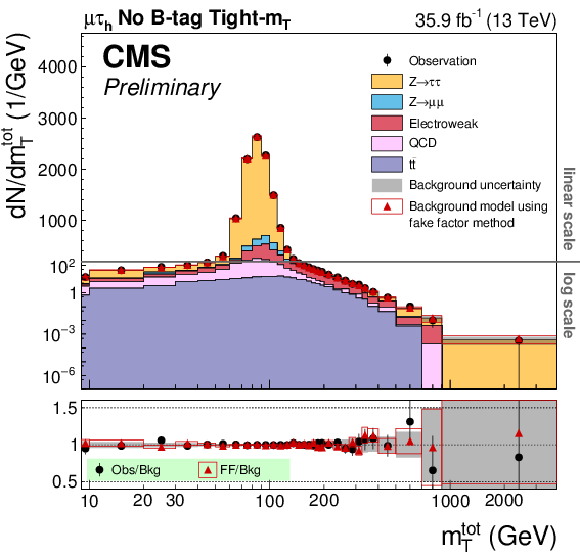
png pdf |
Additional Figure 38:
Distribution of $m_{\text {T}}^{\text {tot}}$ in the No B-tag Tight-$m_{\text {T}}$ event category in the $\mu \tau _{\text {h}} $ final state, using the simulation based cross check as described in the text. The triangles correspond to the background estimate from the fake factor method. The boxes enclosing the triangles correspond to the combined background uncertainty when using the fake factor method. |
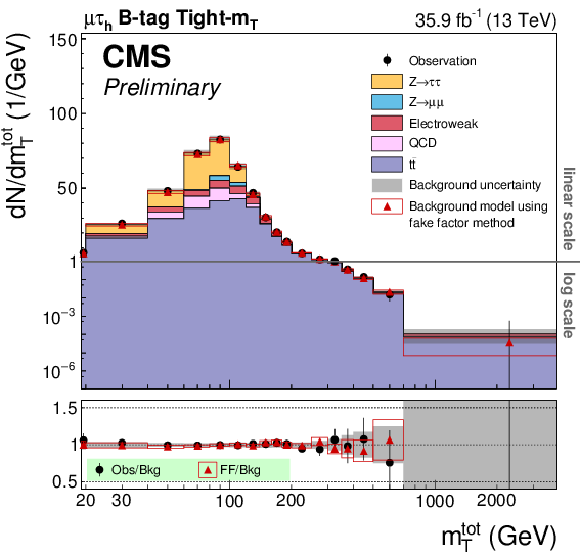
png pdf |
Additional Figure 39:
Distribution of $m_{\text {T}}^{\text {tot}}$ in the B-tag Tight-$m_{\text {T}}$ event category in the $\mu \tau _{\text {h}} $ final state, using the simulation based cross check as described in the text. The triangles correspond to the background estimate obtained from the fake factor method. The boxes enclosing the triangles correspond to the combined background uncertainty when using the fake factor method. |
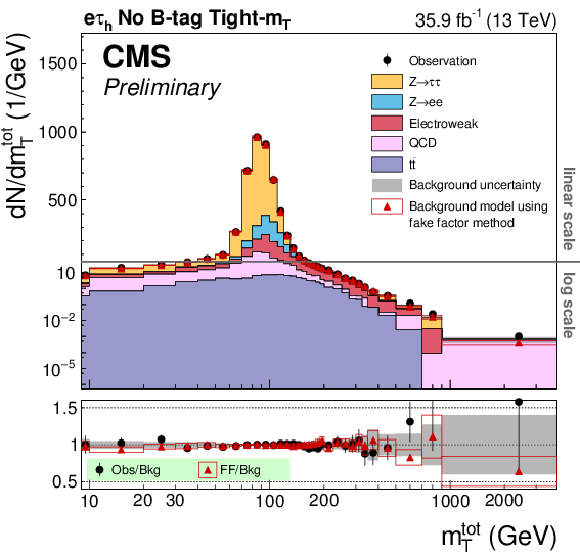
png pdf |
Additional Figure 40:
Distribution of $m_{\text {T}}^{\text {tot}}$ in the No B-tag Tight-$m_{\text {T}}$ event category in the $\mathrm{e} \tau _{\text {h}} $ final state, using the simulation based cross check as described in the text. The triangles correspond to the background estimate obtained from the fake factor method. The boxes enclosing the triangles correspond to the combined background uncertainty when using the fake factor method. |
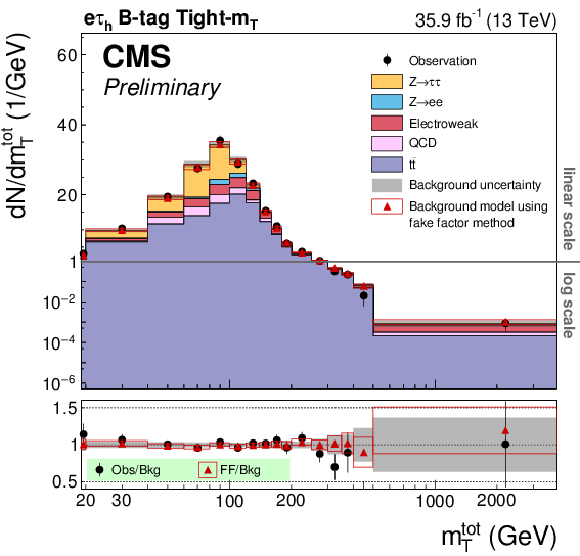
png pdf |
Additional Figure 41:
Distribution of $m_{\text {T}}^{\text {tot}}$ in the B-tag Tight-$m_{\text {T}}$ event category in the $\mathrm{e} \tau _{\text {h}} $ final state, using the simulation based cross check as described in the text. The triangles correspond to the background estimate obtained from the fake factor method. The boxes enclosing the triangles correspond to the combined background uncertainty when using the fake factor method. |

png pdf |
Additional Figure 42:
Distribution of $m_{\text {T}}^{\text {tot}}$ in the No B-tag Tight-$m_{\text {T}}$ event category in the $\mu \tau _{\text {h}} $ final state. Shown is a comparison of the estimate from data using the $\mu \to \tau $ embedding technique with the estimate of the relevant processes from simulation as used for the main analysis, before performing the fit for the statistical inference of the signal. |
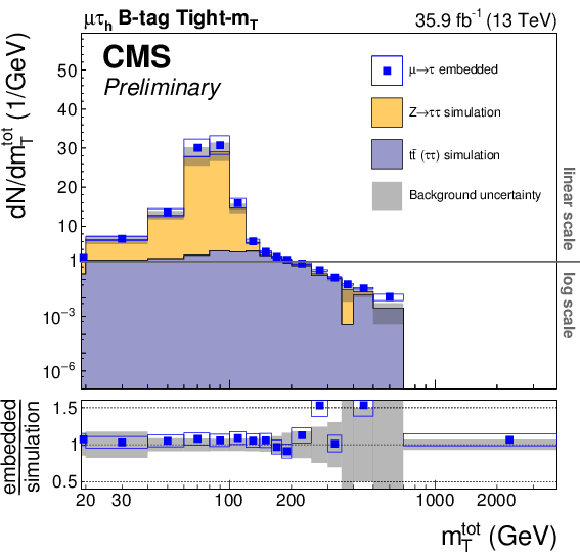
png pdf |
Additional Figure 43:
Distribution of $m_{\text {T}}^{\text {tot}}$ in the B-tag Tight-$m_{\text {T}}$ event category in the $\mu \tau _{\text {h}} $ final state. Shown is a comparison of the estimate from data using the $\mu \to \tau $ embedding technique with the estimate of the relevant processes from simulation as used for the main analysis, before performing the fit for the statistical inference of the signal. |
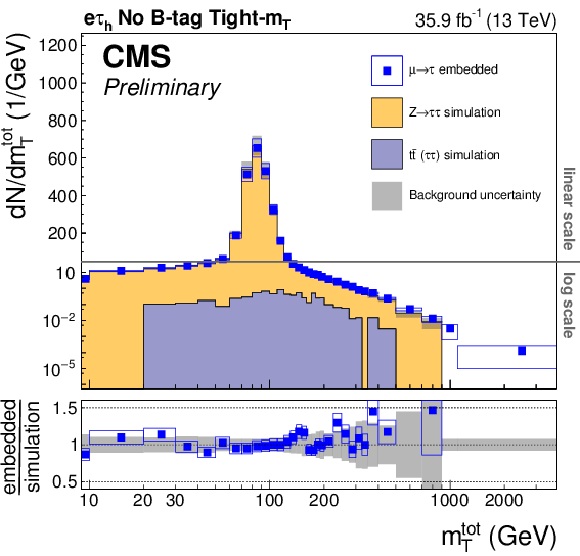
png pdf |
Additional Figure 44:
Distribution of $m_{\text {T}}^{\text {tot}}$ in the No B-tag Tight-$m_{\text {T}}$ event category in the $\mathrm{e} \tau _{\text {h}} $ final state. Shown is a comparison of the estimate from data using the $\mu \to \tau $ embedding technique with the estimate of the relevant processes from simulation as used for the main analysis, before performing the fit for the statistical inference of the signal. |
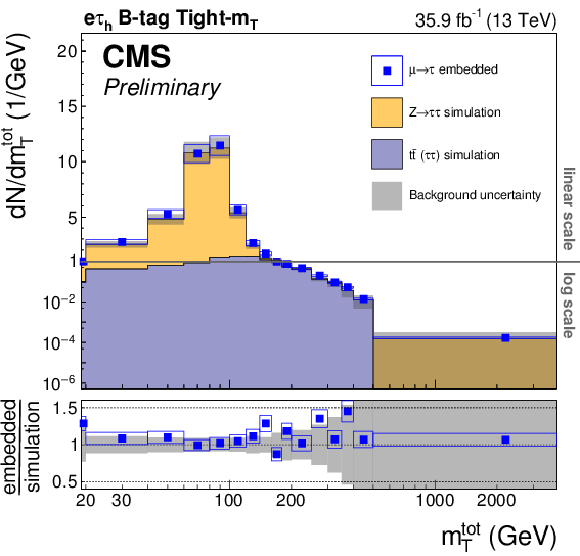
png pdf |
Additional Figure 45:
Distribution of $m_{\text {T}}^{\text {tot}}$ in the B-tag Tight-$m_{\text {T}}$ event category in the $\mathrm{e} \tau _{\text {h}} $ final state. Shown is a comparison of the estimate from data using the $\mu \to \tau $ embedding technique with the estimate of the relevant processes from simulation as used for the main analysis, before performing the fit for the statistical inference of the signal. |
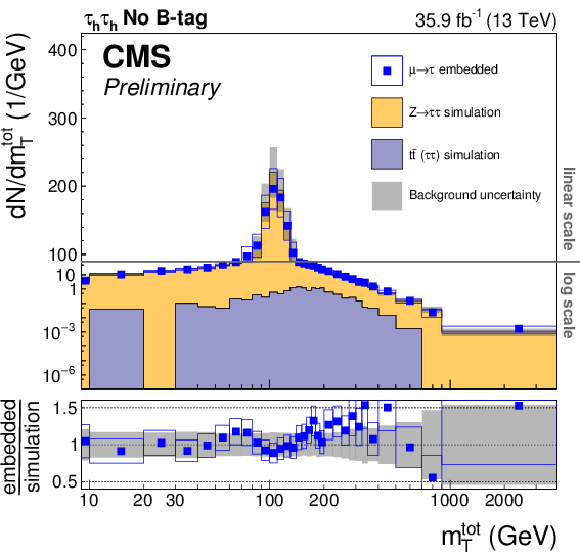
png pdf |
Additional Figure 46:
Distribution of $m_{\text {T}}^{\text {tot}}$ in the No B-tag Tight-$m_{\text {T}}$ event category in the $\tau _{\text {h}} \tau _{\text {h}} $ final state. Shown is a comparison of the estimate from data using the $\mu \to \tau $ embedding technique with the estimate of the relevant processes from simulation as used for the main analysis, before performing the fit for the statistical inference of the signal. |
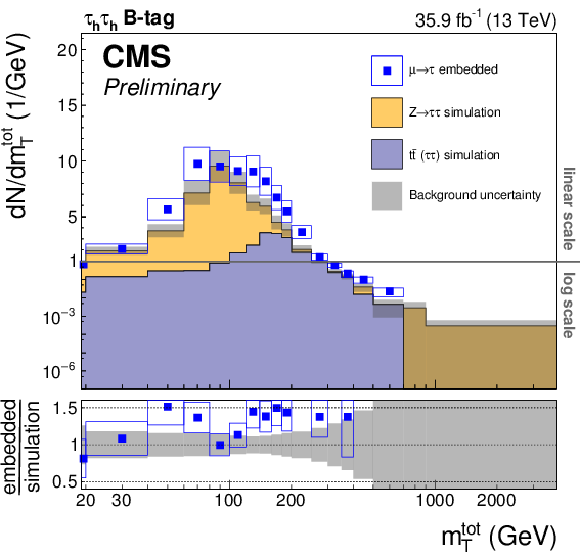
png pdf |
Additional Figure 47:
Distribution of $m_{\text {T}}^{\text {tot}}$ in the B-tag Tight-$m_{\text {T}}$ event category in the $\tau _{\text {h}} \tau _{\text {h}} $ final state. Shown is a comparison of the estimate from data using the $\mu \to \tau $ embedding technique with the estimate of the relevant processes from simulation as used for the main analysis, before performing the fit for the statistical inference of the signal. |
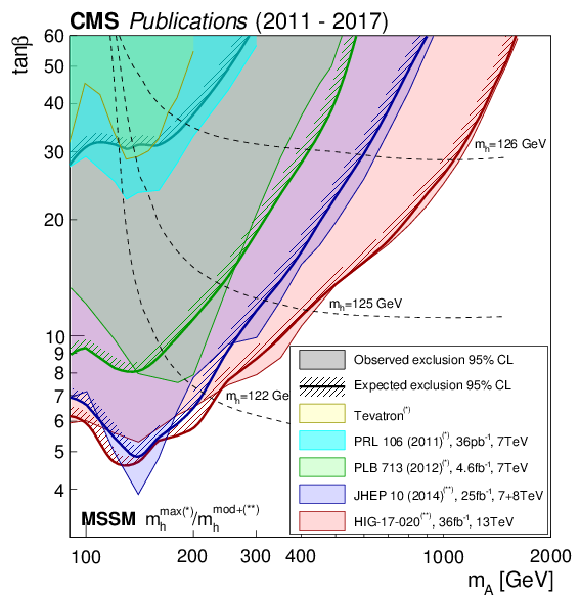
png pdf |
Additional Figure 48:
Expected 95% CL exclusions contours in the $m_{A}$-$\tan\beta $ plane, as published by CMS during the years 2011 till 2017. The exclusions contours are shown in the $m_{h}^{\text {max}}$ respectively $m_{h}^{\text{mod+}}$ scenarios. |
| References | ||||
| 1 | ATLAS Collaboration | Observation of a New Particle in the Search for the Standard Model Higgs Boson with the ATLAS Detector at the LHC | Phys.Lett. B716 (2012) 1--29 | 1207.7214 |
| 2 | CMS Collaboration | Observation of a new boson at a mass of 125 GeV with the CMS experiment at the LHC | PLB716 (2012) 30--61 | CMS-HIG-12-028 1207.7235 |
| 3 | CMS Collaboration | Observation of a new boson with mass near 125 GeV in pp collisions at $ \sqrt{s} = $ 7 and 8 TeV | JHEP 06 (2013) 081 | CMS-HIG-12-036 1303.4571 |
| 4 | P. W. Higgs | Broken symmetries, massless particles and gauge fields | PL12 (1964) 132--133 | |
| 5 | P. W. Higgs | Broken Symmetries and the Masses of Gauge Bosons | PRL 13 (1964) 508--509 | |
| 6 | G. S. Guralnik, C. R. Hagen, and T. W. B. Kibble | Global Conservation Laws and Massless Particles | PRL 13 (1964) 585--587 | |
| 7 | P. W. Higgs | Spontaneous Symmetry Breakdown without Massless Bosons | PR145 (1966) 1156--1163 | |
| 8 | T. W. B. Kibble | Symmetry breaking in nonAbelian gauge theories | PR155 (1967) 1554--1561 | |
| 9 | F. Englert and R. Brout | Broken Symmetry and the Mass of Gauge Vector Mesons | PRL 13 (1964) 321--323 | |
| 10 | ATLAS, CMS Collaboration | Combined Measurement of the Higgs Boson Mass in $ pp $ Collisions at $ \sqrt{s}= $ 7 and 8 TeV with the ATLAS and CMS Experiments | PRL 114 (2015) 191803 | 1503.07589 |
| 11 | ATLAS, CMS Collaboration | Measurements of the Higgs boson production and decay rates and constraints on its couplings from a combined ATLAS and CMS analysis of the LHC pp collision data at $ \sqrt{s}= $ 7 and 8 TeV | JHEP 08 (2016) 045 | 1606.02266 |
| 12 | \relax Yu. A. Golfand and E. P. Likhtman | Extension of the Algebra of Poincare Group Generators and Violation of p Invariance | JEPTL 13 (1971) 323--326.[Pisma Zh. Eksp. Teor. Fiz.13,452(1971)] | |
| 13 | J. Wess and B. Zumino | Supergauge Transformations in Four-Dimensions | NPB70 (1974) 39--50 | |
| 14 | P. Fayet | Supergauge Invariant Extension of the Higgs Mechanism and a Model for the electron and Its Neutrino | NPB90 (1975) 104--124 | |
| 15 | P. Fayet | Spontaneously Broken Supersymmetric Theories of Weak, Electromagnetic and Strong Interactions | PL69B (1977) 489 | |
| 16 | M. Carena et al. | MSSM Higgs Boson Searches at the LHC: Benchmark Scenarios after the Discovery of a Higgs-like Particle | EPJC73 (2013), no. 9 | 1302.7033 |
| 17 | DELPHI, OPAL, ALEPH, LEP Working Group for Higgs Boson Searches, L3 Collaboration | Search for neutral MSSM Higgs bosons at LEP | EPJC47 (2006) 547--587 | hep-ex/0602042 |
| 18 | CDF Collaboration | Search for Higgs bosons predicted in two-Higgs-doublet models via decays to tau lepton pairs in 1.96-TeV p anti-p collisions | PRL 103 (2009) 201801 | 0906.1014 |
| 19 | D0 Collaboration | Search for neutral Higgs bosons in the multi-$ b $-jet topology in 5.2fb$ ^{-1} $ of $ p\bar{p} $ collisions at $ \sqrt{s} = $ 1.96 TeV | PLB698 (2011) 97--104 | 1011.1931 |
| 20 | D0 Collaboration | Search for Higgs bosons decaying to $ \tau\tau $ pairs in $ p\bar {p} $ collisions at $ \sqrt{s} = $ 1.96 TeV | PLB707 (2012) 323--329 | 1106.4555 |
| 21 | CDF Collaboration | Search for Higgs Bosons Produced in Association with $ b $-quarks | PRD85 (2012) 032005 | 1106.4782 |
| 22 | CMS Collaboration | Search for a Higgs boson decaying into a b-quark pair and produced in association with b quarks in proton~proton collisions at 7 TeV | PLB722 (2013) 207--232 | CMS-HIG-12-033 1302.2892 |
| 23 | CMS Collaboration | Search for neutral MSSM Higgs bosons decaying into a pair of bottom quarks | JHEP 11 (2015) 071 | CMS-HIG-14-017 1506.08329 |
| 24 | ATLAS Collaboration | Search for the neutral Higgs bosons of the Minimal Supersymmetric Standard Model in $ pp $ collisions at $ \sqrt{s}= $ 7 TeV with the ATLAS detector | JHEP 02 (2013) 095 | 1211.6956 |
| 25 | CMS Collaboration | Search for neutral MSSM Higgs bosons decaying to $ \mu^{+} \mu^{-} $ in pp collisions at $ \sqrt{s} = $ 7 and 8 TeV | PLB752 (2016) 221--246 | CMS-HIG-13-024 1508.01437 |
| 26 | ATLAS Collaboration | Search for neutral Higgs bosons of the minimal supersymmetric standard model in pp collisions at $ \sqrt{s} = $ 8 TeV with the ATLAS detector | JHEP 11 (2014) 056 | 1409.6064 |
| 27 | ATLAS Collaboration | Search for Minimal Supersymmetric Standard Model Higgs bosons $ H/A $ and for a $ Z^{\prime} $ boson in the $ \tau \tau $ final state produced in $ pp $ collisions at $ \sqrt{s}= $ 13 TeV with the ATLAS Detector | EPJC76 (2016), no. 11, 585 | 1608.00890 |
| 28 | CMS Collaboration | Search for Neutral MSSM Higgs Bosons Decaying to Tau Pairs in $ pp $ Collisions at $ \sqrt{s}= $ 7 TeV | PRL 106 (2011) 231801 | CMS-HIG-10-002 1104.1619 |
| 29 | CMS Collaboration | Search for neutral Higgs bosons decaying to tau pairs in $ pp $ collisions at $ \sqrt{s}= $ 7 TeV | PLB713 (2012) 68--90 | CMS-HIG-11-029 1202.4083 |
| 30 | CMS Collaboration | Search for neutral MSSM Higgs bosons decaying to a pair of tau leptons in pp collisions | JHEP 10 (2014) 160 | CMS-HIG-13-021 1408.3316 |
| 31 | CMS Collaboration | Description and performance of track and primary-vertex reconstruction with the CMS tracker | JINST 9 (2014) P10009 | CMS-TRK-11-001 1405.6569 |
| 32 | CMS Collaboration | Performance of photon reconstruction and identification with the CMS detector in proton-proton collisions at $ \sqrt{s} = $ 8 TeV | JINST 10 (2015) P08010 | CMS-EGM-14-001 1502.02702 |
| 33 | CMS Collaboration | Performance of Electron Reconstruction and Selection with the CMS Detector in Proton-Proton Collisions at ~s = 8 TeV | JINST 10 (2015), no. 06, P06005 | CMS-EGM-13-001 1502.02701 |
| 34 | CMS Collaboration | Performance of CMS muon reconstruction in $ {\mathrm{p}}{\mathrm{p}} $ collision events at $ \sqrt{s}= $ 7 TeV | JINST 7 (2012) P10002 | CMS-MUO-10-004 1206.4071 |
| 35 | CMS Collaboration | The CMS trigger system | JINST 12 (2017) P01020 | CMS-TRG-12-001 1609.02366 |
| 36 | CMS Collaboration | The CMS experiment at the CERN LHC | JINST 3 (2008) S08004 | CMS-00-001 |
| 37 | CMS Collaboration | Particle-flow reconstruction and global event description with the CMS detector | JINST 12 (2017), no. 10, P10003 | CMS-PRF-14-001 1706.04965 |
| 38 | K. Rose | Deterministic annealing for clustering, compression, classification, regression, and related optimization problems | Proceedings of the IEEE 86 (Nov, 1998) 2210--2239 | |
| 39 | H. Voss, A. Hocker, J. Stelzer, and F. Tegenfeldt | TMVA, the Toolkit for Multivariate Data Analysis with ROOT | in XIth International Workshop on Advanced Computing and Analysis Techniques in Physics Research (ACAT), p. 40 2007 | physics/0703039 |
| 40 | M. Cacciari, G. P. Salam, and G. Soyez | FastJet user manual | EPJC 72 (2012) 1896 | 1111.6097 |
| 41 | CMS Collaboration | Identification of b-quark jets with the CMS experiment | JINST 8 (2013) P04013 | CMS-BTV-12-001 1211.4462 |
| 42 | CMS Collaboration | Reconstruction and identification of $ \tau lepton $ decays to hadrons and $ \tau _\mathrm{g}n $ at CMS | JINST 11 (2016), no. 01, P01019 | CMS-TAU-14-001 1510.07488 |
| 43 | CMS Collaboration | Performance of reconstruction and identification of tau leptons in their decays to hadrons and tau neutrino in LHC Run-2 | CMS-PAS-TAU-16-002 | CMS-PAS-TAU-16-002 |
| 44 | J. Alwall et al. | MadGraph 5 : Going Beyond | JHEP 06 (2011) 128 | 1106.0522 |
| 45 | J. Alwall et al. | The automated computation of tree-level and next-to-leading order differential cross sections, and their matching to parton shower simulations | JHEP 07 (2014) 079 | 1405.0301 |
| 46 | P. Nason | A New method for combining NLO QCD with shower Monte Carlo algorithms | JHEP 11 (2004) 040 | hep-ph/0409146 |
| 47 | S. Frixione, P. Nason, and C. Oleari | Matching NLO QCD computations with Parton Shower simulations: the POWHEG method | JHEP 11 (2007) 070 | 0709.2092 |
| 48 | S. Alioli, P. Nason, C. Oleari, and E. Re | NLO Higgs boson production via gluon fusion matched with shower in POWHEG | JHEP 04 (2009) 002 | 0812.0578 |
| 49 | S. Alioli, P. Nason, C. Oleari, and E. Re | A general framework for implementing NLO calculations in shower Monte Carlo programs: the POWHEG BOX | JHEP 06 (2010) 043 | 1002.2581 |
| 50 | S. Alioli et al. | Jet pair production in POWHEG | JHEP 04 (2011) 081 | 1012.3380 |
| 51 | E. Bagnaschi, G. Degrassi, P. Slavich, and A. Vicini | Higgs production via gluon fusion in the POWHEG approach in the SM and in the MSSM | JHEP 02 (2012) 088 | 1111.2854 |
| 52 | K. Melnikov and F. Petriello | Electroweak gauge boson production at hadron colliders through O(alpha(s)**2) | PRD74 (2006) 114017 | hep-ph/0609070 |
| 53 | N. Kidonakis | Top Quark Production | in Proceedings, Helmholtz International Summer School on Physics of Heavy Quarks and Hadrons (HQ 2013): JINR, Dubna, Russia, July 15-28, 2013, pp. 139--168 2014 | 1311.0283 |
| 54 | J. M. Campbell and R. K. Ellis | MCFM for the Tevatron and the LHC | NPPS 205-206 (2010) 10--15 | 1007.3492 |
| 55 | T. Sjostrand, S. Mrenna, and P. Z. Skands | A Brief Introduction to PYTHIA 8.1 | CPC 178 (2008) 852--867 | 0710.3820 |
| 56 | E. Bagnaschi et al. | Resummation ambiguities in the Higgs transverse-momentum spectrum in the Standard Model and beyond | JHEP 01 (2016) 090 | 1510.08850 |
| 57 | E. Bagnaschi and A. Vicini | The Higgs transverse momentum distribution in gluon fusion as a multiscale problem | JHEP 01 (2016) 056 | 1505.00735 |
| 58 | R. V. Harlander, H. Mantler, and M. Wiesemann | Transverse momentum resummation for Higgs production via gluon fusion in the MSSM | JHEP 11 (2014) 116 | 1409.0531 |
| 59 | NNPDF Collaboration | Unbiased global determination of parton distributions and their uncertainties at NNLO and at LO | NPB855 (2012) 153--221 | 1107.2652 |
| 60 | CMS Collaboration | Event generator tunes obtained from underlying event and multiparton scattering measurements | EPJC76 (2016), no. 3, 155 | CMS-GEN-14-001 1512.00815 |
| 61 | S. Agostinelli et al. | G4--a simulation toolkit | Nuclear Instruments and Methods in Physics Research Section A: Accelerators, Spectrometers, Detectors and Associated Equ\ ipment 506 (2003), no. 3, 250 -- 303 | |
| 62 | CMS Collaboration | Measurements of Inclusive $ W $ and $ Z $ Cross Sections in $ pp $ Collisions at $ \sqrt{s}= $ 7 TeV | JHEP 01 (2011) 080 | CMS-EWK-10-002 1012.2466 |
| 63 | CMS Collaboration | Measurement of the differential cross section for top quark pair production in pp collisions at $ \sqrt{s} = $ 8 TeV | EPJC75 (2015), no. 11, 542 | CMS-TOP-12-028 1505.04480 |
| 64 | CMS Collaboration | Evidence for the 125 GeV Higgs boson decaying to a pair of $ \tau $ leptons | JHEP 05 (2014) 104 | CMS-HIG-13-004 1401.5041 |
| 65 | ATLAS Collaboration | Modelling $ Z\rightarrow\tau\tau $ processes in ATLAS with $ \tau $-embedded $ Z\rightarrow\mu\mu $ data | JINST 10 (2015), no. 09, P09018 | 1506.05623 |
| 66 | A. L. Read | Linear interpolation of histograms | NIMA425 (1999) 357--360 | |
| 67 | CMS Collaboration | CMS Luminosity Measurements for the 2016 Data Taking Period | CMS-PAS-LUM-17-001, CERN, Geneva | |
| 68 | LHC Higgs Cross Section Working Group Collaboration | Handbook of LHC Higgs Cross Sections: 4. Deciphering the Nature of the Higgs Sector | 1610.07922 | |
| 69 | A. D. Martin, W. J. Stirling, R. S. Thorne, and G. Watt | Parton distributions for the LHC | EPJC63 (2009) 189--285 | 0901.0002 |
| 70 | A. D. Martin, W. J. Stirling, R. S. Thorne, and G. Watt | Uncertainties on alpha(S) in global PDF analyses and implications for predicted hadronic cross sections | EPJC64 (2009) 653--680 | 0905.3531 |
| 71 | T. Junk | Confidence level computation for combining searches with small statistics | NIMA434 (1999) 435--443 | hep-ex/9902006 |
| 72 | A. L. Read | Presentation of search results: The CL(s) technique | JPG28 (2002) 2693--2704, .[,11(2002)] | |
| 73 | The ATLAS Collaboration, The CMS Collaboration, The LHC Higgs Combination Group Collaboration | Procedure for the LHC Higgs boson search combination in Summer 2011 | CMS-NOTE-2011-005 | |
| 74 | CMS Collaboration | Combined results of searches for the standard model Higgs boson in $ pp $ collisions at $ \sqrt{s}= $ 7 TeV | PLB710 (2012) 26--48 | CMS-HIG-11-032 1202.1488 |
| 75 | L. Maiani, A. D. Polosa, and V. Riquer | Bounds to the Higgs Sector Masses in Minimal Supersymmetry from LHC Data | PLB724 (2013) 274--277 | 1305.2172 |
| 76 | A. Djouadi et al. | The post-Higgs MSSM scenario: Habemus MSSM? | EPJC73 (2013) 2650 | 1307.5205 |
| 77 | A. Djouadi et al. | Fully covering the MSSM Higgs sector at the LHC | JHEP 06 (2015) 168 | 1502.05653 |
| 78 | G. Degrassi et al. | Towards high precision predictions for the MSSM Higgs sector | EPJC 28 (2003) 133--143 | hep-ph/0212020 |
| 79 | B. C. Allanach et al. | Precise determination of the neutral Higgs boson masses in the MSSM | JHEP 09 (2004) 044 | hep-ph/0406166 |
| 80 | LHC Higgs Cross Section Working Group Collaboration | Handbook of LHC Higgs Cross Sections: 3. Higgs Properties | 1307.1347 | |
| 81 | R. V. Harlander, S. Liebler, and H. Mantler | SusHi: A program for the calculation of Higgs production in gluon fusion and bottom-quark annihilation in the Standard Model and the MSSM | CPC 184 (2013) 1605--1617 | 1212.3249 |
| 82 | M. Spira, A. Djouadi, D. Graudenz, and P. M. Zerwas | Higgs boson production at the LHC | NPB453 (1995) 17--82 | hep-ph/9504378 |
| 83 | R. V. Harlander and M. Steinhauser | Supersymmetric Higgs production in gluon fusion at next-to-leading order | JHEP 09 (2004) 066 | hep-ph/0409010 |
| 84 | R. Harlander and P. Kant | Higgs production and decay: Analytic results at next-to-leading order QCD | JHEP 12 (2005) 015 | hep-ph/0509189 |
| 85 | G. Degrassi and P. Slavich | NLO QCD bottom corrections to Higgs boson production in the MSSM | JHEP 11 (2010) 044 | 1007.3465 |
| 86 | G. Degrassi, S. Di Vita, and P. Slavich | NLO QCD corrections to pseudoscalar Higgs production in the MSSM | JHEP 08 (2011) 128 | 1107.0914 |
| 87 | G. Degrassi, S. Di Vita, and P. Slavich | On the NLO QCD Corrections to the Production of the Heaviest Neutral Higgs Scalar in the MSSM | EPJC72 (2012) 2032 | 1204.1016 |
| 88 | R. V. Harlander and W. B. Kilgore | Next-to-next-to-leading order Higgs production at hadron colliders | PRL 88 (2002) 201801 | hep-ph/0201206 |
| 89 | C. Anastasiou and K. Melnikov | Higgs boson production at hadron colliders in NNLO QCD | NPB646 (2002) 220--256 | hep-ph/0207004 |
| 90 | V. Ravindran, J. Smith, and W. L. van Neerven | NNLO corrections to the total cross-section for Higgs boson production in hadron hadron collisions | NPB665 (2003) 325--366 | hep-ph/0302135 |
| 91 | R. V. Harlander and W. B. Kilgore | Production of a pseudoscalar Higgs boson at hadron colliders at next-to-next-to leading order | JHEP 10 (2002) 017 | hep-ph/0208096 |
| 92 | C. Anastasiou and K. Melnikov | Pseudoscalar Higgs boson production at hadron colliders in NNLO QCD | PRD67 (2003) 037501 | hep-ph/0208115 |
| 93 | U. Aglietti, R. Bonciani, G. Degrassi, and A. Vicini | Two loop light fermion contribution to Higgs production and decays | PLB595 (2004) 432--441 | hep-ph/0404071 |
| 94 | R. Bonciani, G. Degrassi, and A. Vicini | On the Generalized Harmonic Polylogarithms of One Complex Variable | CPC 182 (2011) 1253--1264 | 1007.1891 |
| 95 | S. Dittmaier, M. Kramer, 1, and M. Spira | Higgs radiation off bottom quarks at the Tevatron and the CERN LHC | PRD 70 (2004) 074010 | hep-ph/0309204 |
| 96 | S. Dawson, C. B. Jackson, L. Reina, and D. Wackeroth | Exclusive higgs boson production with bottom quarks at hadron colliders | PRD 69 (Apr, 2004) 074027 | |
| 97 | R. V. Harlander and W. B. Kilgore | Higgs boson production in bottom quark fusion at next-to-next-to-leading order | PRD 68 (Jul, 2003) 013001 | |
| 98 | R. Harlander, M. Kramer, and M. Schumacher | Bottom-quark associated Higgs-boson production: reconciling the four- and five-flavour scheme approach | 1112.3478 | |
| 99 | S. Heinemeyer, W. Hollik, and G. Weiglein | FeynHiggs: A Program for the calculation of the masses of the neutral CP even Higgs bosons in the MSSM | CPC 124 (2000) 76--89 | hep-ph/9812320 |
| 100 | S. Heinemeyer, W. Hollik, and G. Weiglein | The Masses of the neutral CP - even Higgs bosons in the MSSM: Accurate analysis at the two loop level | EPJC 9 (1999) 343--366 | hep-ph/9812472 |
| 101 | M. Frank et al. | The Higgs Boson Masses and Mixings of the Complex MSSM in the Feynman-Diagrammatic Approach | JHEP 02 (2007) 047 | hep-ph/0611326 |
| 102 | T. Hahn et al. | High-Precision Predictions for the Light CP -Even Higgs Boson Mass of the Minimal Supersymmetric Standard Model | PRL 112 (2014), no. 14, 141801 | 1312.4937 |
| 103 | A. Djouadi, J. Kalinowski, and M. Spira | HDECAY: A Program for Higgs boson decays in the standard model and its supersymmetric extension | CPC 108 (1998) 56--74 | hep-ph/9704448 |

|
Compact Muon Solenoid LHC, CERN |

|

|

|

|

|

|